The Ultimate Guide to the Best 3D Printing Software 2020

Choosing software for 3D printing suitable for one’s proficiency level, goals and preferences is becoming more difficult by the day. In this article, we’ll try to make this process easier and tell you about the best 3D printing software that is still relevant in 2020. We will divide the software into several categories and list the best solutions in each section.
In the article, we aim to showcase both commercial and free software. Please note that certain programs were included twice, but in different categories, since they can be used for multiple purposes and still perform great.
3D Modeling Software
Today, engineering, architecture, and graphic design are almost impossible to imagine without 3D modeling. More than that, 3D modeling software has become so advanced, that you can create 3D animations, CGI and even develop video games using your home desktop computer.
Dozens of new 3D modeling programs are developed each year. Some of them are user-friendly enough for hobbyists, others are geared towards professional use. Let’s check out 3D modeling programs that are so far the most popular.
For beginners
3D Slash
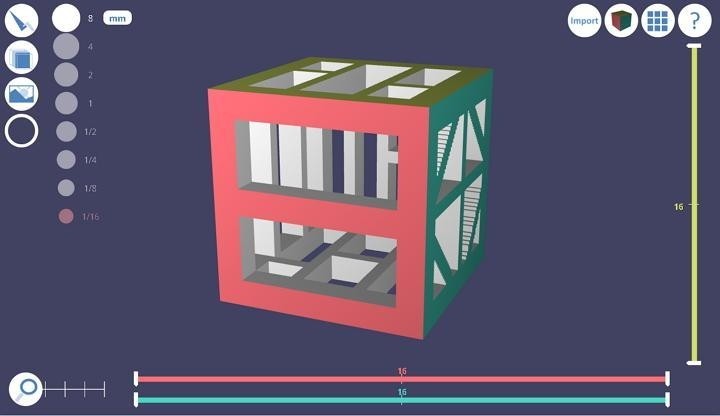
This free user-friendly 3D modeling system operates on a plain building block approach, like the one in Minecraft. In order to build up figures and sceneries, a user applies solid blocks, which can be modified with a wide range of tools. This principle of 3D design is simple yet effective: you get an opportunity to develop accurate digital models ready for printing in no time and without the necessity of training.
The basic item in this system is the cuboid. Designers modify it with the use of hammers, trowels, drills, and other instruments. The sizes of the tools are adjustable – simply select the parameter you need for certain purposes.
This playful, intuitive software is great for beginners, who don’t feel like plunging into the depths of 3D design. They can get acquainted with 3D Slash tutorials and start developing their digital sculptures in a matter of minutes.
The software is free and compatible with Windows, Mac, and Linux devices.
Clara.io
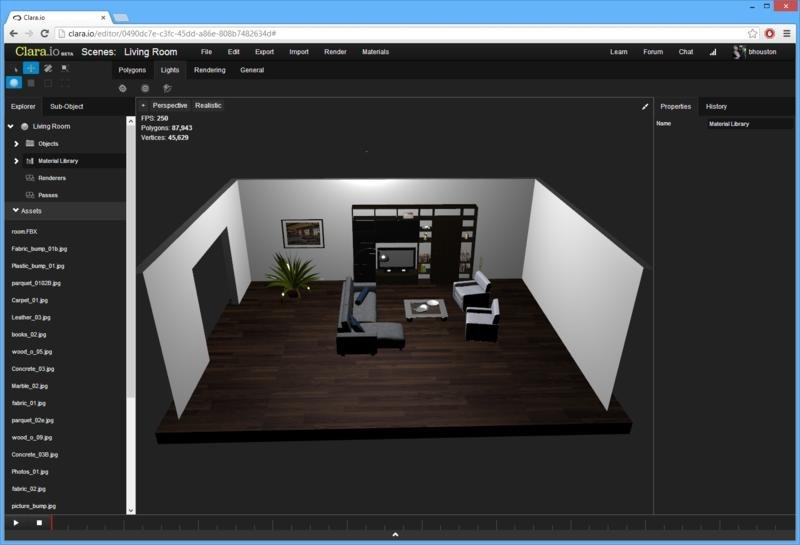
This powerful browser-based 3D modeling solution is free of charge and suitable for both experienced and novice users. It features an impressive assortment of basic tools for slicing, cutting, canting, looping, and so on. There is UV mapping in this system. The program includes the V-Ray renderer, which highlights the designer’s meshes with an HDR image. It also supports basic keyframe animation for the creation of computer-animated movies.
The users of Clara.io can develop their projects in teams, with automatically saved history of changes. All the improvements of the model are instantaneously synchronized among the accounts.
One more advantage of Clara.io is that it offers every user up to 5GB cloud storage. You can also buy additional storage space for commercial 3D designing projects. The commercial variation of the software includes unlimited private scenes and unlimited personal rendering.
FractalLab
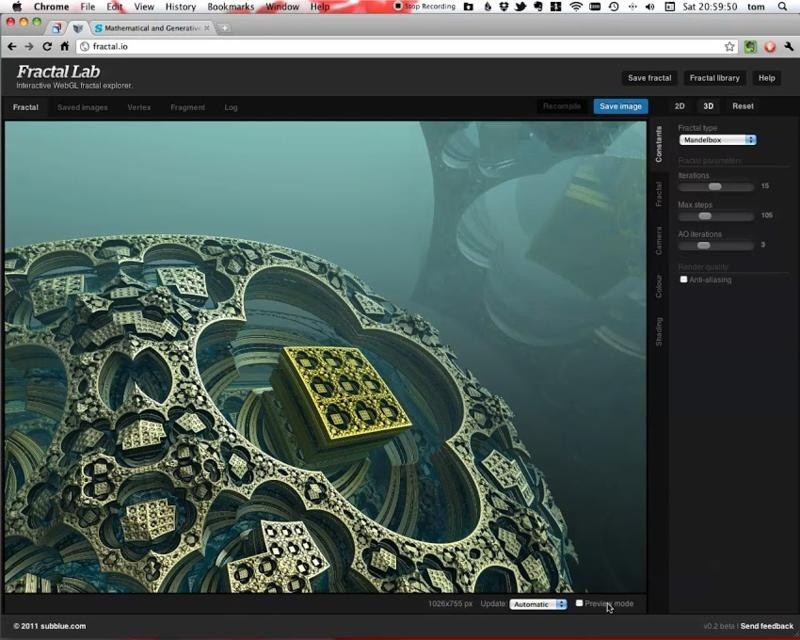
FractalLab’s operation screen
FractalLab was developed in 2011 as a free WebGL 3D modeling program. This software is based on fractal 3D modeling. The concept is quite simple in theory: the software offers different kinds of fractals to choose from. In order to create your own 3D model, you have to introduce some changes to such parameters, like smoothness, level of detail or scale. In addition to that, this software gives the possibility to play around with different textures and make the design even more realistic with the help of shading tools. Advanced camera control allows users to view the model from many different angles, which makes it possible to spot any imperfections without any troubles.
Though FractalLab is a completely free 3D modeling program, it enables you to take full control over your 3D design, objects, and the scene thanks to its extensive array of settings.
It’s important to mention that creating a brand new fractal from ground zero is not an easy task. It requires a profound grasp of mathematics and geometry. Still, even novice users can enjoy thousands of various fractals, which can be found in FractalLab’s extensive library. You can explore the intricate designs and even modify them as you like.
FractalLab is a browser-based program, which means that you don’t have to download and install any applications to your desktop. To save and share your 3D creations, you’ll have to use Dropbox API for rendering images, and NodeWebkit for animations.
- OS: Browser
- Price: Free
FractalLab tutorial:
Moment of Inspiration

With its robust functionality and intuitive interface, Moment of Inspiration or shortly “MoL” is one of the most demanded software suits for 3D designers. It features, for instance, non-uniform rational B-spline surfaces, all sorts of transformations, and a variety of basic modeling tools. In this system, all the mathematical processes are hidden, so that a user could enjoy the artistic freedom of digital design.
Unlike other 3D CAD programs, MoL has a very simple user interface. It is totally compatible with pen tablets, and a user can easily go without the keyboard. The learning curve is pretty short here: you will easily develop high-end mechanical or organic meshes off the top of your head.
The software of MoI is a great solution for those, who give precedence to the creative process over the technical aspect of 3D modeling. The product is fee-based and compatible with Mac and Windows devices.
SculptGL

3D model of Chewbacca created in SculptGL
Sometimes you want to create a 3D object for printing without getting too much into 3D modeling. In this case, you can avoid working with dozens of confusing tools and setups of traditional 3D modeling programs and turn to 3D sculpting apps. Take SculptGL as an example. SculptGL is a browser-based open-source application, which is available for free. More than that, you don’t have to install any software to your PC or even sign up to use the program, which is always a plus for a quick modeling job.
Creating a 3D object in SculptGL is very similar to working with clay. This means that even beginners with no previous experience in 3D modeling or digital design can make their creations in this program.
In SculptGL, any object begins with a ball of clay, which then can be molded changed. You can modify the starting shape by removing some layers or adding more material using wide brush strokes. This way you can easily create the basic shape of your object. Then, when the silhouette is defined, you can add finer details. More than that, SculptGL offers a symmetry option, which can help make your designs even more consistent and beautiful.
It is important to mention that SculptGL is very simple, that’s why the feature set is quite limited. For example, it is impossible to make holes or hollow out your designs in the program. For this reason, you may need additional 3D modeling or slicing software to make your models printable. It won’t be a problem, since it is possible to import and export models, which were created in SculptGL, in a variety of 3D file formats, including OBJ, STL, and PLY.
- OS: Browser
- Price: Free
SculptGL tutorial:
SelfCAD

SelfCAD is a full-featured online application for 3D sculpting, modeling, and printing. All the tools you may require for these purposes are available within a single system. The product is cloud-based, so there is no necessity of downloading any software. What is more, the program includes a wide range of tutorials and a training course for novices and those, who feel shaky in the sphere of 3D designing.
With SelfCAD, you can download flat images for the purpose of creating a three-dimensional model. Using a broad selection of instruments for slicing, piping, screwing, and other operations, you will easily create the necessary shape – precise and totally ready for printing.
There is a host of predetermined RepRap 3D printers in this system, available for every user by default. You can also add the specifications for any device you’d like to use.
SketchUp
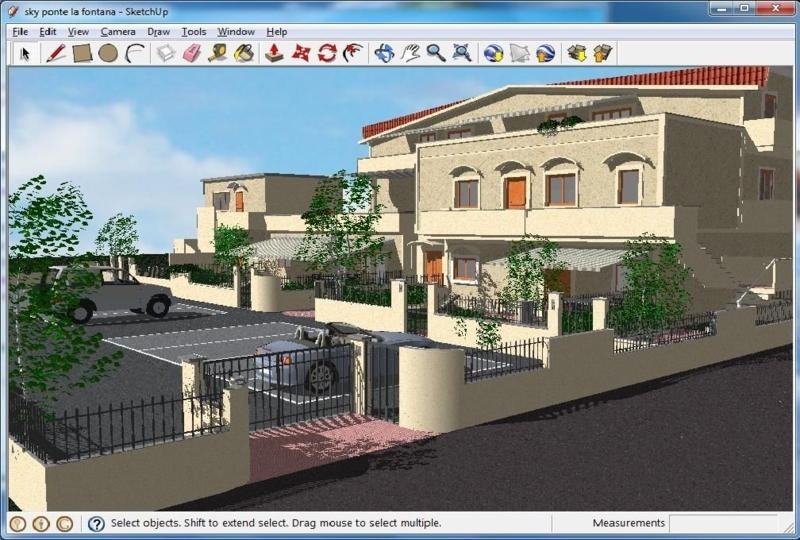
Being a well-known visualization and planning instrument, the software of SketchUp is frequently used in architecture, interior design, engineering, and other spheres. With its neat interface and intuitive navigation, the system is great for beginners, who want to grasp the basic principles of 3D modeling.
The potential capabilities of SketchUp are almost unlimited, as there is a wide breadth of extensions for this platform. Most of them are free of charge. The software supports, for instance, CADspan, Curviloft, and Solid Inspector2. With SketchUp, you can download your 3D models into 3D Warehouse – an online library connected to the printing service Materialise.Cloud. The latter will automatically detect and correct all the shortcomings of your models, whereafter you can upload them for further 3D printing.
This platform does not support STL items by default. Instead, it saves files with the extension “SketchUp STL”. That doesn't present challenges for users, however, as they can download and save items in their preferred extension.
TinkerCAD

TinkerCAD doesn’t require anything but a web-browser. You don’t need any additional instruments – just open TinkerCAD and start modeling your 3D objects. The program lets users combine primitive shapes and improve them with the use of basic instruments. It is a great experience for beginners, who are learning the fundamentals of 3D art.
This doesn’t mean, however, that TinkerCAD is not interesting for experienced modelers. It offers a number of more complicated tools for seasoned designers with far-reaching purposes. All the designs created by the software users are saved in the cloud in .stl. format. You can print them or trace the process of modeling from beginning to end. Besides, TinkerCAD enables team members to develop their projects through collaboration, irrespective of where they are located.
The software is totally free for non-commercial use.
Intermediate
Blender
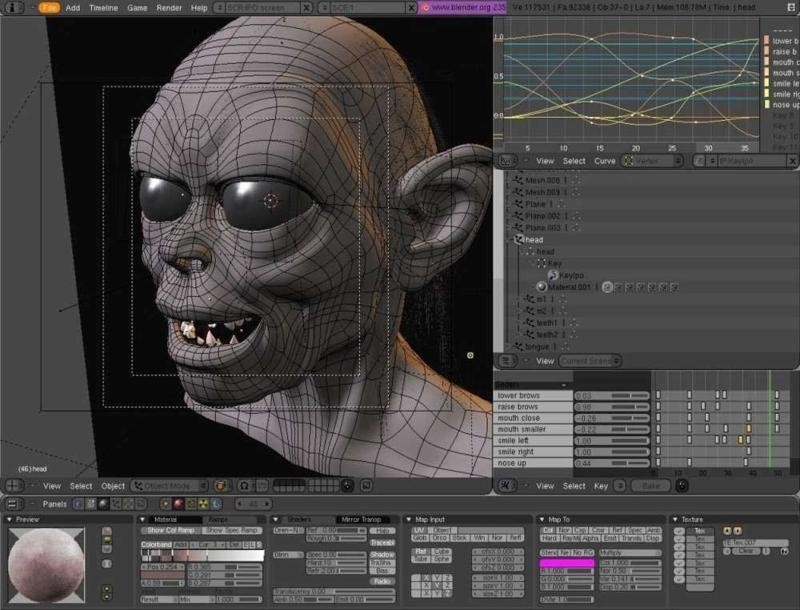
Blender is one of the most popular open-source 3D modeling programs featuring a wide range of user-friendly tools. It offers, for instance, texturing, sculpting, particle simulation, animation and rigging, video editing, and so on. With this solution, you can create arts, animated films, visual effects, interactive applications – and, what is especially important for us – 3D printed models. Its sculpting options are similar to ones in Mudbox or ZBrush. Besides, there is an integrated game engine in Blender software.
The software of Blender can be expanded with various plug-ins. It is constantly improved and changed in line with users’ requirements and preferences. Despite the fact that there is plenty of free learning material in this system, it is aimed at seasoned 3D modelers and animation artists rather than newbies. The program is intuitive and easy-to-operate, yet packed with opportunities to pick from. It is a Jack-of-all-trades, as users say, great for everyone who has a clue about 3D modeling.
DesignSpark

Being a freemium 3D modeling software, DesignSpark features a good choice of common CAD instruments. It allows users to create 2D and 3D models, borrow components from a large library, and modify their digital objects for further printing. With this software, one can move, pull, fill, and combine graphical objects for the sake of building and editing the necessary geometry. These are also several specialized tools in this system, aimed at the construction of mathematically precise forms: Measure, Dimension, and others.
The developers of DesignSpark made the system free of charge, but there is certain payment for additional functions. For instance, you will have to pay for extended import and export options. The software is compatible with Windows devices only. It supports .rsdoc, .dxf, .ecad, .emn, .iges, and other formats.
Daz Studio / Hexagon

Daz Studio
Daz 3D is an American software company that focuses on creating an application for 3D design and animation. Daz 3D products, such as Daz Studio and Hexagon, are targeted for digital artists who are looking to create and animate their 3D characters. The apps are comprehensive enough for 3D modeling enthusiasts, as well as advanced enough to meet the needs of professional artists.
In 2005, Daz 3D launched Daz Studio, a free scene creator software that can serve as an alternative to Poser. Daz Studio enables you to create and render scenes for still images as well as animations and videos. This free application provides access to Daz 3D’s huge library of free 3D content. You can find and play around with unique designs and introduce them to your own projects. If that is not enough for you, a whole world of premium 3D creations are available if you are willing to pay a little extra.
Daz Studio enables you to simulate beautiful life-like hair and cloth movements thanks to dForce physics technology, which is integrated into this free software. This, along with Genesis 8, and the NVIDIA Iray render engine option makes it possible to create realistic images and animations with whiplash speed. On top of that, this free software provides a face transfer feature, which allows you to create realistic models of whoever you wish by recreating their face shape, bone structure, texture and even skin complexion in 3D.

Hexagon’s operation screen
If you are interested in creating your own 3D characters from scratch, Daz 3D’s Hexagon can be the right choice for you. The main approach of this free application is subdivision modeling, although spline and surface tools are included as well. The app’s extensive toolset will allow you to create new models, or modify existing ones. You can play around with such parameters as build, size, and length of limbs. 3D sculpting feature was added to the application in the later versions, which makes Hexagon a great tool for creating organic models.
These two programs are a perfect combo for creating animations. The puppeteer tool allows you to animate your 3D characters by simply sifting your mouse between the different poses which are represented by the nodes in the grid. Another amazing feature of this application is its interpolation function. It enables you to choose two different poses for your character and the software will generate all of the movements in between them automatically. This will help you make sure that your animation looks seamless and realistic without any additional hassle.
Though it already seems too good to be true, these applications are available completely free of charge. On top of that, you can sell your 3D creations on Daz 3D’s marketplace.
- OS: Windows, mac OS
- Price: Free
Hexagon review:
FreeCAD
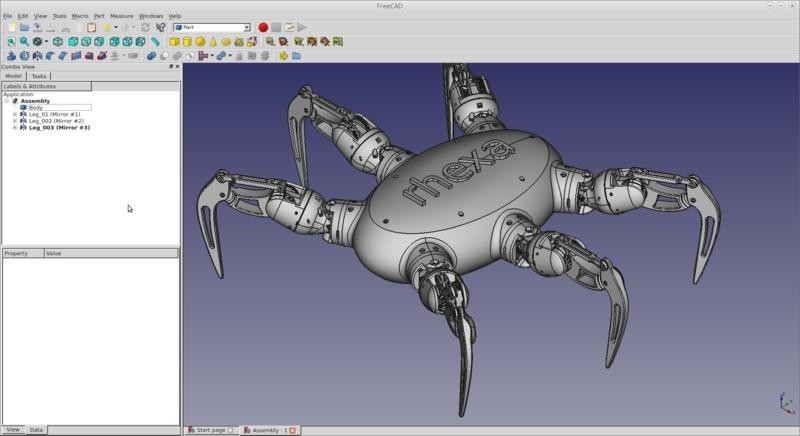
This parametric free 3D modeling program is targeted primarily at the development of real-life objects of any size. It is highly customizable, scriptable, and open-ended. It lets users not only modify their digital objects, but also track the history of changes and get back to the original template at any stage of the modeling process.
The software of FreeCAD has a modular architecture; there is a variety of plug-ins, which can enhance the functionality of the application. It can generate, display, and rearrange G code. There is a Sketcher for the creation of 2D shapes and a robot simulator for the operations with robot movements. Users can also apply to the path module aimed at the mechanical processing of 3D components.
Having quite a simple interface, FreeCAD seems, however, a bit overwhelming for beginning 3D designers. Try dig deeper into this powerful system – and you will be rewarded with awesome results.
LibreCAD

LibreCAD is an open-source 3D designing system available in more than 30 languages and supporting .dxf and .dwg formats. The software is free and intuitive so that even inexperienced users could realize its benefits. Featuring a wide selection of modeling tools, it displays 2D visual images and isometric views of the objects under development.
There is a command-line at the bottom of the page, which streamlines the current workflow; you can apply to it at any moment. LibreCAD’s toolbar includes the line, polyline, spline, dimension, and other instruments. There are drawing options in the system, such as layers, hatches, templates, advanced snapping, and so on. You can add some text to your model and edit it at any stage of 3D design.
LibreCAD is perfect for everyone, from beginners to intermediate users, who are keen on architectural and mechanical design.
MakeHuman
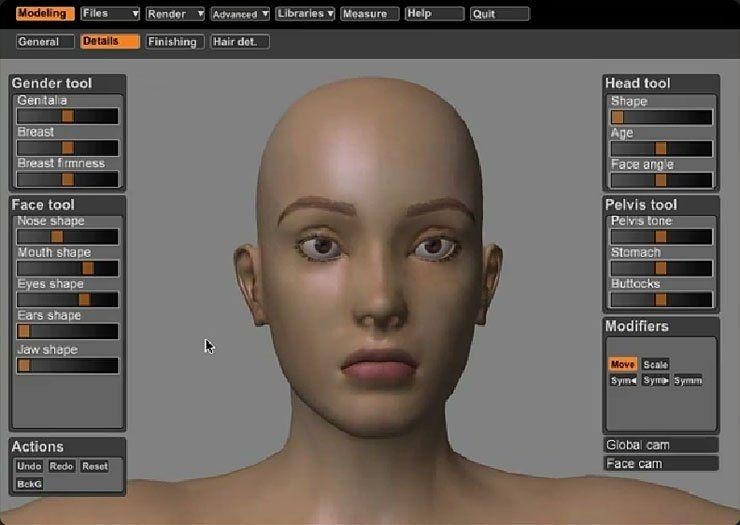
This open-source software is aimed at the creation of realistic appearance 3D virtual human models. It lets users focus on details – skin color, the shape of teeth and eyes, length of eyelashes, and so on. Besides, the system takes into account a number of common parameters specified by the artist, such as the model’s age, gender, ethnics, weight, height, etc. The author creates the total look of the human figure – its clothes, hairdo, shoes, accessories, and so on. When the 3D image is ready – it is exported to .obj, .mhx, .bhv or .dae formats and then printed.
The software of MakeHuman is constantly improved and upgraded. It lets modelers create a mesh that can be refined with the help of 3D sculpting solutions. There is also a dedicated instrument for Blender users, facilitating the exchange between these two platforms. MakeHuman is great for artists, who want to create true-to-life 3D human models using a variety of handy tools. Moreover, with this solution, they get free access to the artists’ blog, collaborative workspace, and code versioning.
MagicaVoxel

MagicaVoxel’s operation screen
MagicaVoxel is a free 3D modeling program where you can create complex 3D designs by combining and manipulating simple cubical shapes - voxels. The inspiration for this concept came from such video games, as Minecraft and Monument Valley, where you also can build the world by adding and breaking cubical shapes.
3D modeling in MagicaVoxel is very simple with its drag-and-drop style tools. For example, you can easily extract a whole line of blocks using the line tool. This software also offers a wide range of other features, which allow you to select, move, delete or change the size of the groups of blocks. To make the modeling process quick and efficient, MagicaVoxel offers a number of predefined brushes and voxel patterns. You can use them to create complex detailed models or freehand simpler designs as well.
One of the best features of this software is its neat and clutter-free interface. You can paint your voxel designs with a great variety of colors, represented in the form of pallets. You can use preset color pallets or customize your own.
Despite how simple this software is, it still needs some getting used to. Some modes in the program can affect only the surface of the mesh, while others allow to select layers or work inside the volume of a mesh. Another great feature of the software is the opportunity to create simple animations by duplicating and slightly modifying shapes. On top of that, this free 3D modeling program offers a rendering feature, which makes it possible to use such advanced effects as HDR emissive materials.
- OS: Windows, Mac OS.
- Price: Free
MagicaVoxel overview:
MeshMixer

3D model of a bunny, created in MeshMixer
Along with TinkerCad, Meshmixer is another free 3D modeling tool, developed by Autodesk. Since Meshmixer has a truly mind-bogglingly long list of features, it has every right to be marketed as a “Swiss Army Knife” for 3D meshes. It is truly an indispensable tool for everyone who practices 3D modeling and printing.
Meshmixer is a completely independent manual program. Its main purpose is to prepare 3D meshes for printing and to repair and improve your mesh designs. This software provides a wide range of optimization tools, which can help to point out the weaker parts of your mesh and fix them accordingly to make your 3D models more stable. To further refine your designs, you can switch to sculpting mode which helps to work on smaller details.
In addition to that, it is possible to hollow out your models in the app, which significantly reduces the cost and printing time. Other features of the program include scaling, remeshing, automatic alignment of surfaces, and many others. In addition to that, Meshmixer enables stability and thickness analysis. This feature will help to ensure that your 3D model won’t collapse on itself during printing and all of the structures will be sturdy and durable.
Other features of the program include an intuitive drag-and-drop, which allows you to add details, such as ears, antlers and other pieces, to make your designs unique and recognizable. On top of that, it is possible to combine several STL files with each other using the app’s Meshmix-mode.
- OS: Windows, Mac OS, Linux.
- Price: Free
MeshMixer overview:
nanoCAD
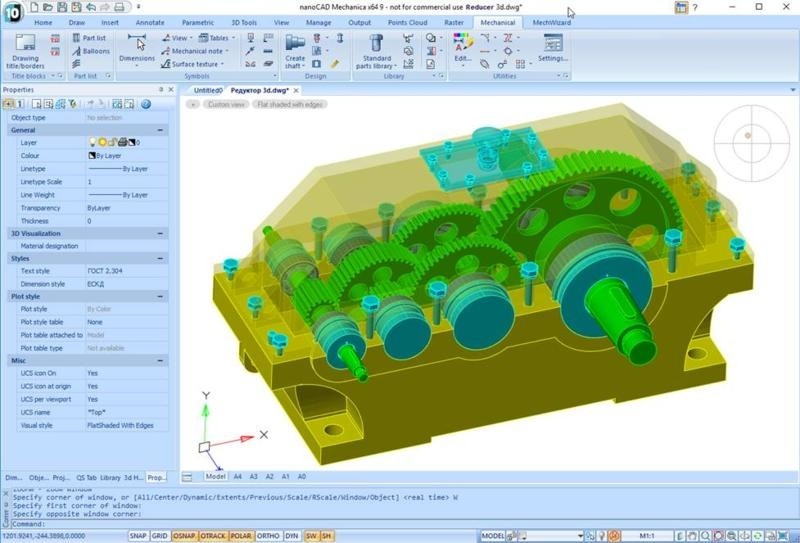
The software of nanoCAD is offered in three versions – basic (free), Pro, and Plus (the latter two are fee-based). Its interface if frequently compared to the one of Autodesk’s AutoCAD: the systems have much in common, so users easily switch between them.
nanoCAD involves users into a simple, yet effective parametric modeling workflow. They can dispose of any of their older designs and modify them in accordance with new circumstances. All the models can be processed with a broad range of instruments. What is more, the software automates many routine processes, so that a user could focus on the most important tasks, requiring manual manipulation.
The product meets the requirements of both seasoned 3D designers and beginners. Its functionality can be extended via a set of plug-ins. In paid versions of nanoCAD, you get the opportunity to operate a professional level toolbox, including solid-modeling and other much-in-demand options.
OpenSCAD
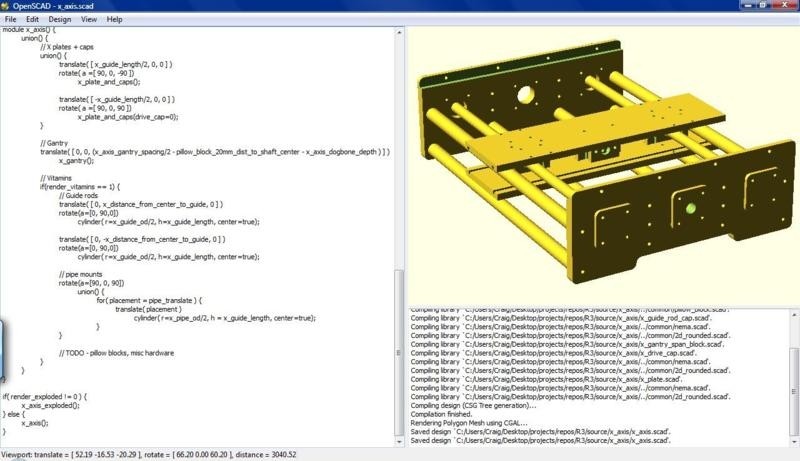
This system offers a different approach to the very process of 3D modeling. It is focused on the creation of solid CAD items. Based on the textual description language, OpenSCAD operates as a 3D compiler. It is more suitable for engineers rather than artists.
The software represents two modeling schemes: constructive solid geometry and extrusion of 2D outlines. It allows a user to define the modifications of graphic primitives and use them for the development of 3D models. All the changes of 3D models are transmitted into corresponding numbers. The latter are preserved till the end of the modeling project so that the creator could track the measurable aspect of the model. All this facilitates the adjustment of the 3D object’s core features.
OpenSCAD is, by all means, not everybody's cup of tea. It is an excellent solution for experienced 3D modeling enthusiasts, who have an engineering mindset.
Sculptris
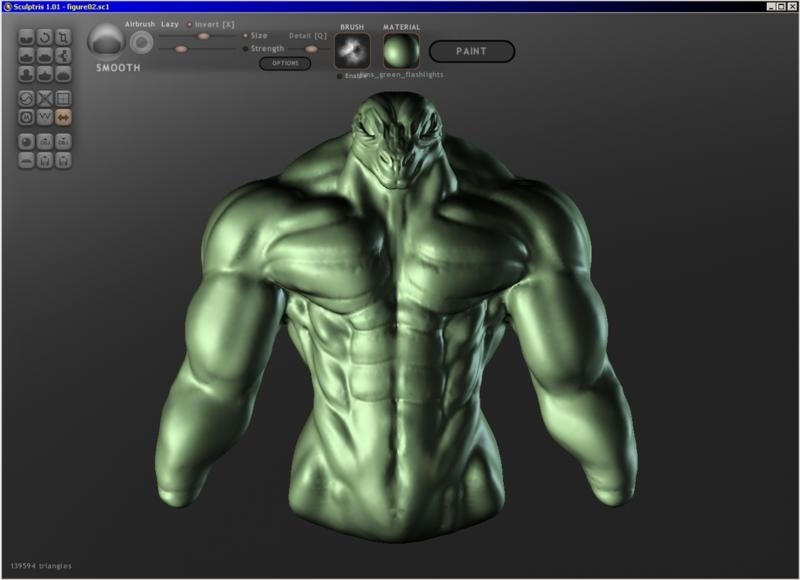
This platform is intuitive and easy-to-use. Even beginners can start producing their first printed objects after a brief overview of the software. Sculptris is based on the principle of sculpture. Like a professional sculptor, you don’t build a high-resolution mesh out of hand, but create the model by layers, stage by stage. The basis of your 3D objects, like bones and flesh, will have no details – you will add them gradually, from bigger to smaller ones.
The major tool in this system is a brush. A user is offered a wide range of brushes of different shapes and sizes in order to design all possible details of objects, from limbs to wrinkles and hair. This free 3D modeling software is great for intermediate digital sculptors, who are not ready yet to commit to more complicated solutions.
Sculptris supports .obj files. It is only compatible with Windows and Mac OS.
Vectary

Vectary’s operation screen
Vectary is a free open-source 3D design software, which works in the majority of modern browsers. The app stands out from its competitors’ thanks to its sleek and user-friendly interface that gives even novice users without a background in 3D modeling and digital art an opportunity to create beautiful complex 3D designs. With this software, you can customize the standard templates, modify and edit models from the app’s digital library, or create your own designs from scratch.
One of the best features of the app is its advanced cloud-based collaboration mode. It makes Vectary an amazing tool for group projects since you can invite friends and colleagues to collaborate on a design in real-time. It is possible to make changes in the design simultaneously without interfering with the others’ work. Finished models can be saved to the cloud storage and then shared with other 3D modeling enthusiasts.
With the free version of the app, you can work on up to three personal projects, as well as make use of most of the software’s advanced tools, including various generative and texturing features. You can save your designs as images and share them with other 3D modeling enthusiasts. In case you want to be able to export your beautiful models for 3D printing, you’ll have to splurge on Vectary’s monthly premium subscription, which is only $9 a month.
- OS: Browser
- Price: Free/$9 per month
Vectary review:
Professional
3DS Max
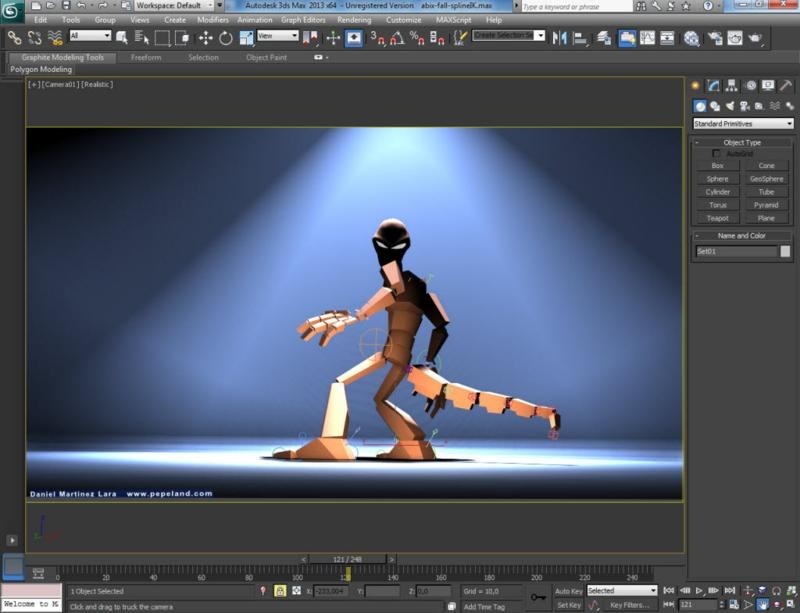
The 3DS Max software is popular among video game developers, digital effects creators, and architectural visualization companies. It features an integrated system of light simulation and a cloth-simulator. The program has its own scripting language and the engine for the creation of digital objects from point cloud data.
The product’s toolset includes a number of instruments for the development of spline-based objects, parametric and organic polygon models, and subdivision surfaces. There are also NURBS-based designing tools in 3DS Max, which let users build up organic and mathematically precise meshes.
With its plug-in architecture, 3DS Max can be easily enhanced and upgraded. Use it together with other Autodesk’s solutions – and the results will surprise you to the upside.
Bforartists
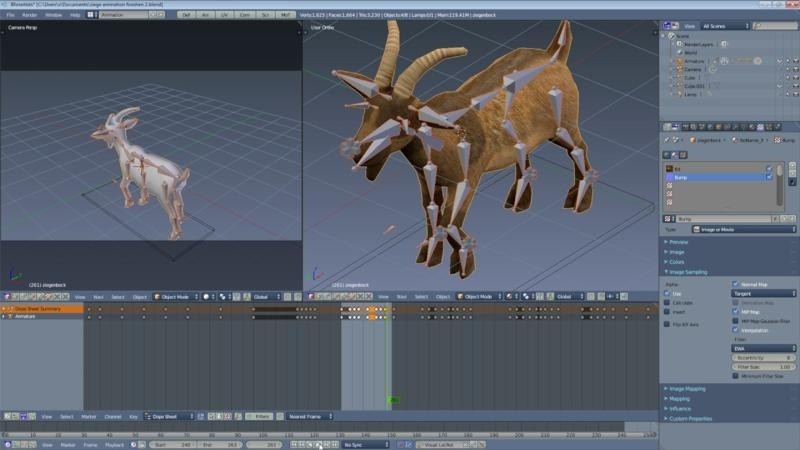
Bforartists’ operation screen
Bforartists is a free open-source software for creating 3D content for professional and amateur digital artists. It was developed as an alternative to Blender, which is famous for its extensive feature set and wide field of application. Despite this, Blender is commonly despised for its incomprehensible setup and cluttered interface. Bforartists tried to solve this problem.
Blender and Bforartists have identical sets of features. Everything that can be done in Blender can also be recreated in Bforartists. The main difference lies in the user interface. While Blender usability relies on hotkeys for speedy operation, the second program makes use of an uncluttered user-friendly graphical menu, which makes working in the program much more pleasant and convenient.
Bforartists offers its users an opportunity to create 3D still images, animations, video game graphics and even prerendered movies. This program gives access to a great variety of tools for polygon modeling. If you want to create finer structures, you can use the 3D sculpting feature. On top of that, you can perform and automate several modeling tasks simultaneously using Python scripting. In addition to that, Bforartists provides a great number of materials for your meshes, as well as UV mapping for texturing.
For realistic animation, Bforartists offers a rigging function, which helps your meshes have a stable skeletal structure. This feature includes envelope, skeleton and automatic skinning, mirror functionality, weight painting, bone layers and colored groups for organization. A wide range of animation features includes non-linear animation for independent movements, automated walk-cycles along paths and an advanced character animation pose editor. To make your animations even more life-like, Bforartists offers a great number of simulation tools, including fluid, smoke, hair, cloth, particles and even full rigid body physics.
Bforartists supports a whole range of 2D and 3D formats, such as Jpg, PNG, OpenEXR, Obj, X, FBX or Collada. Needless to say, this software also natively reads and writes Blender files.
You can tailor Bforartist to suit your needs even more with numerous Blender add-ons and plugins. More than that, you can customize the program’s menu and make it truly your own.
- OS: Windows, Mac OS, Linux.
- Price: Free
Bforartists vs Blender review:
Cinema 4D
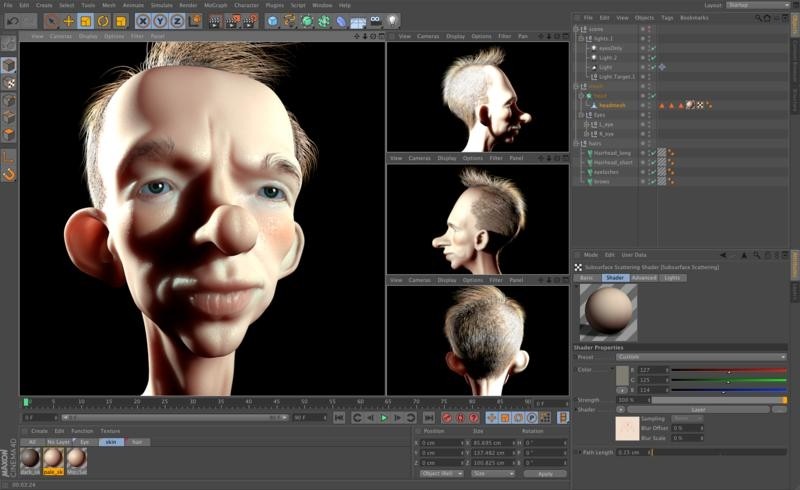
This intuitive and powerful solution is popular among professional 3D artists, who are aimed at the creation of advanced 3D graphics. It allows users to create, render, and modify digital models of all shapes and sizes for different purposes, be that movie production or three-dimensional printing.
The list of Cinema 4D instruments includes the LOD tool, which simplifies digital constructions based on their distance from the camera, and the Scene Reconstruction, which lets users combine colored point clouds and geometry in the most efficient way. Powered by OpenGL, the system helps designers to control the focus range and screen space reflections. In order to speed up the process of 3D modeling, the developers enriched the software with the so-called ‘mirroring function’: you can create only a half of your model, whereafter the second half will be mirrored.
Cinema 4D is a perfect solution for the professionals in the visual effects and computer game industries. It is fee-based and compatible with Windows and macOS.
Modo
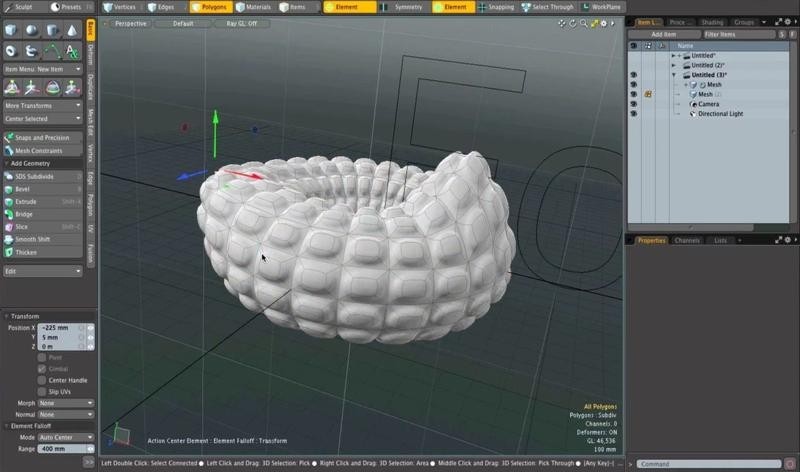
It is a full-featured software suite designed to meet the needs of VFX and 3D modeling professionals. As distinguished from other enterprise-class programs, modo is very easy to learn. The system offers polygon and subdivision modeling tools, a particle engine, and algorithmic animation. There is also a selection instrument, which lets 3D designers paint components in different ways: in loops, in patterns, etc. A user can always select the most suitable improvement mode for each model.
With modo, you can record macros of repetitive operations and use them when needed. This approach speeds up the process of 3D modeling. Besides, the software includes a number of tools that let users build digital shapes like modeling clay with your own hands.
Available for Windows, macOS, and Linux. Once-only payment.
Mudbox
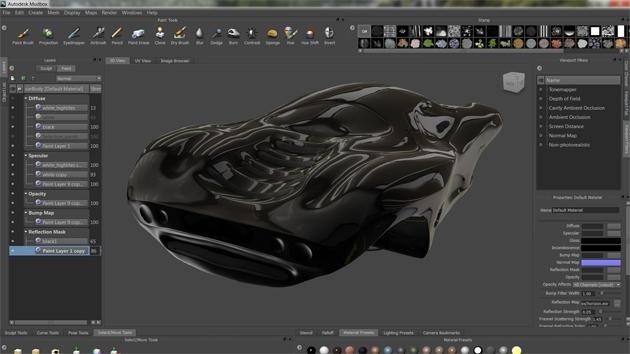
Mudbox incorporated the techniques of clay sculpting into the art of 3D designing. The base figure acquires details gradually, layer by layer. A modeler uses brushes of different size (from the biggest to the smallest) in order to build up the targeted figure. First, you define a silhouette with indistinct features and then add its limbs, muscles, hairs, fingers, facial features, and so on. Finally, you can paint the 3D model using a number of paint tools.
Many users combine Mudbox with other Autodesk solutions. For instance, they take characters from Maya for sculpting and texturing or borrow assets for the creation of more detailed geometry. The product is frequently purchased along with other Autodesk programs, which is both cost-effective and practical.
The software supports three formats: .fbx, .mud, and .obj.
Onshape

It is an enterprise-level 3D computer-aided design system, aimed at seasoned users with serious purposes. This software is available on all possible devices, including iPhones and Android phones. The users of Onshape can work in teams: all the members of the group get instant access to the project and the same CAD-generated data. The software is cloud-based, so that you won’t have to install it on your device.
With Onshape, you can create your 3D models without the necessity to save copies and keep a check on file versions. All the information is saved automatically in the cloud – you can access it at any time and from any place.
The software supports a wide range of file formats, including .sat, .step, .iges, .sldprt, .3dm, .dae, . x_t, .x_b, .xxm_txt, and so on. In spite of its comparatively high price, Onshape is an excellent solution for professional and industrial designers working in teams.
Poser
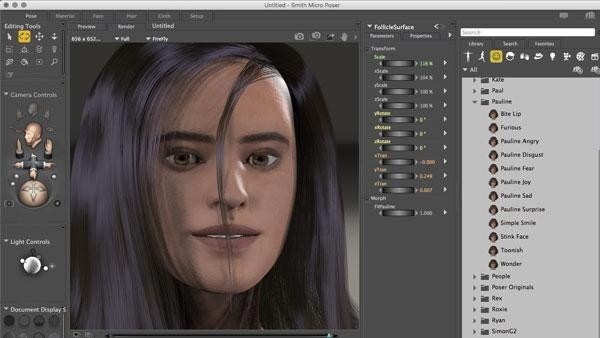
As distinguished from other 3D modeling systems, Poser lets users create humans and animals in a matter of minutes. The thing is it offers a genderless humanoid pattern, which is changed and improved in compliance with the designer’s needs. This “base figure” is customized up to the tiniest detail: the user applies to multifold sliding bars that account for the model's flesh – its skin, hair, clothes, etc. Thus, the software of Poser allows designers to create photorealistic 3D sculptures – easily and quickly.
Besides, the program features an integrated library of pre-built 3D images, which can be borrowed and customized for your personal targets. There are humans, animals, and scenery objects, so that you could build up the whole scenes. All the characters are fully ready for animation in films and games.
Poser is offered in a paid version. There is also Poser Pro, which allows its users to implement performance capture technology via Microsoft Kinect.
Terragen

Desert scenery created in Terragen
Terragen is a free scenery generator, developed by Planetside Software for Windows and Linux. WithTerragen, it is possible to create the most intricate and beautiful landscapes and even entire planets. These views look so realistic that it is a challenge to differentiate them from scenery photos. This photorealism is achieved by Terragen’s advanced shader system, which includes sophisticated shading and texturing features.
The workflow is based on the procedural node approach, which gives you total control of your creation. Terragen provides access to a mind-blowingly extensive digital library. There you can choose from a wide range of preset objects, such as trees, rocks, and other landscape details to make your scene even more life-like.
Terragen will allow you to generate realistic simulations of volumetric clouds, fog, sky, stars, and even ozone layer imitation. The software also provides advanced context-aware lens effects, such as bloom or starbursts, which can help bring your scenery to life. They take into account such parameters as the source of the light, specular reflection intensity, atmospheric scattering, and color. On top of that, all of the licensed versions of Terragen offer animation capabilities as well.
To make the work process easier, the app provides an opportunity to import digital elevation model files of existing sceneries that can help you visualize your own unique landscape and guide your work. Another great feature of the program is Terragen’s powerful rendering engine, which will enable you to render your scenes in mere moments.
The free version of the app has some functional limitations. Unfortunately, high rendering resolution, animation capabilities and a wide range of other handy features are available only in the paid version of Terragen. But if you want to create landscapes of high quality for commercial use, Terragen is worth investing in.
- OS: Windows, Mac OS, and Linux
- Price: $348/year for Terragen Professional subscription
Terragen demo video:
ZBrush
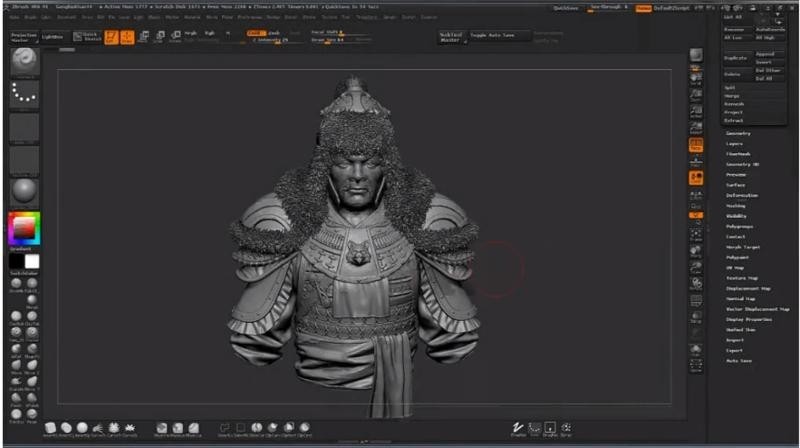
It is a powerful solution for 3D modeling professionals. The software is fee-based. Offering a good few of tools for the creation of first-rate digital sculptures, ZBrush lets users experience the advantages of the so-called ‘progressive detailing’. Its principle is simple, yet effective: you create your sculpture step by step, proceeding from the general silhouette to smaller details. First, you use very broad brushes, moving gradually to smaller ones. This process is quite complicated and time-consuming – but it allows designers to achieve really impressive results.
There is also a plug-in for this software – “3D Print Exporter”, – which facilitates the procedure of 3D figure printing. The program supports the formats .dxf, .goz, .obj, .vrml, and so on. Users often compare ZBrush to its competitor Mudbox; the latter, however, has no tools for the creation of base geometry (for this purpose, designers have to rely on Maya or 3ds Max). ZBrush is absolutely self-supporting in this respect.
Rhino3D
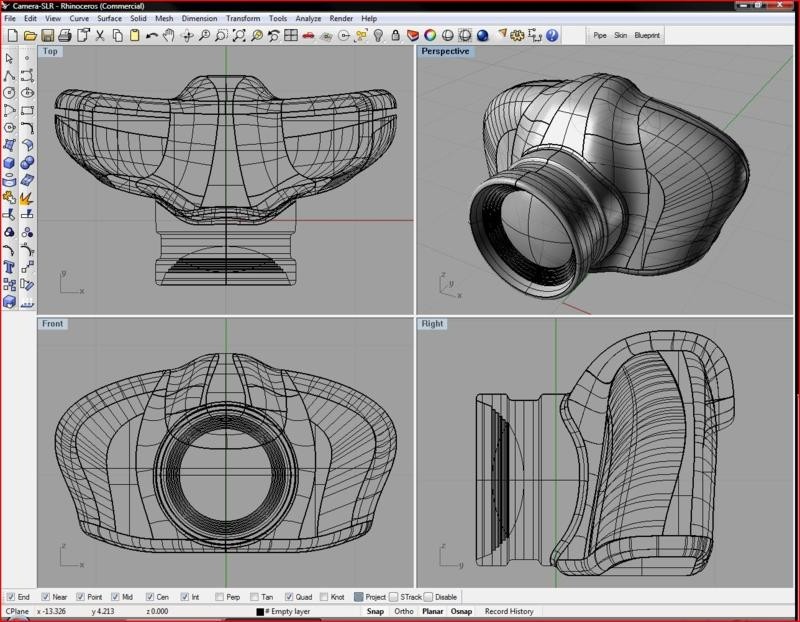
Rhino3D is widely used for the purposes of computer-aided design, computer-aided manufacturing, fast-turn prototyping, digital printing, and backward engineering in a number of spheres. It offers a selection of multimedia and graphic design tools. There are no dedicated 3D printing instruments in this product, but its built-in options are more than enough for digital modeling.
The software of Rhino3D is founded on the NURBS mathematical simulation technique, aimed at the development of mathematically calibrated representations of curves and arbitrary geometry surfaces in the sphere of computer-generated imagery. A user can build 3D figures of all shapes, modify them, and prepare for further printing with Rhino3D built-in features and additional plug-ins.
It is a perfect choice for professional 3d modelers and designers, who are fond of mathematically sound figures. The software is paid.
MeshLab
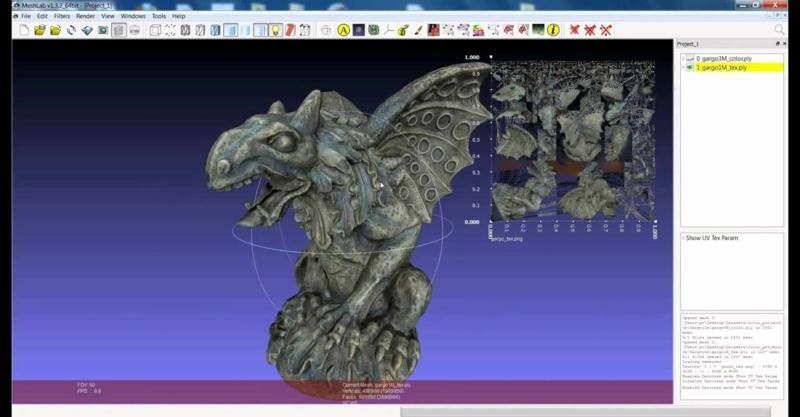
Being a high-demand 3D mesh processing system, MeshLab offers a variety of instruments for editing, cleaning, inspecting, and converting different types of meshes. It is used mostly in technical spheres of 3D development and data processing. Based on the VCG library, the program is available for Windows, MacOSX, and Linux. With MeshLab, you can detect and remove meshes from models of all sizes, paint interfaces for smoothing and coloring meshes, and use a wide range of filters (for remeshing, mesh cleaning, colorization/inspection).
The software features a number of 3D scanning instruments for aligning meshes into the same model space and for Poisson mesh merging. There is also a slicing tool, a measuring tool, an option of interactive mesh painting, and a variety of other important opportunities in this system. MeshLab is the first open-source program to operate with U3D: now you can convert 3D meshes directly into this format. Besides, it supports Point Clouds, so that a user could save 3D models composed of points only in PLY and OBJ formats.
BRL-CAD
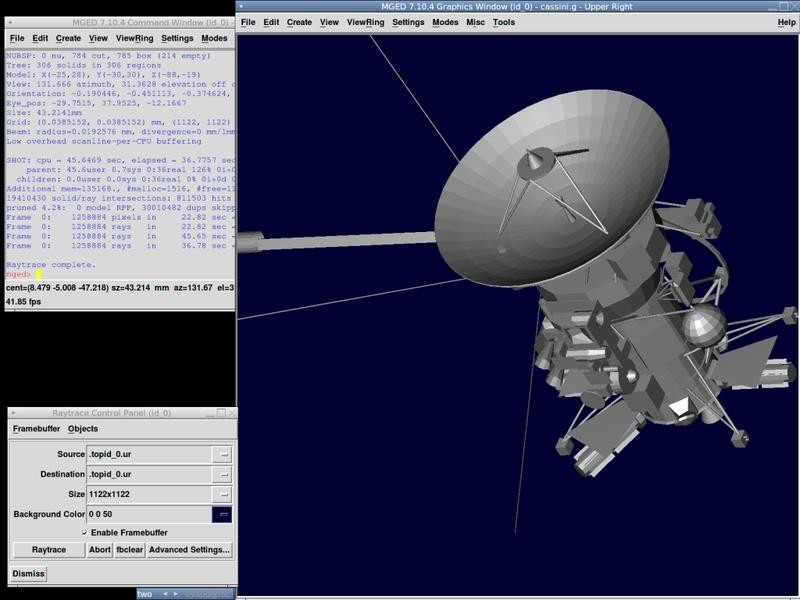
BRL-CAD is a powerful cross-platform 3D modeling solution featuring a variety of tools for interactive geometry editing, high-performance ray-tracing, scripting, image-processing, and other purposes. There is an impressive library of geometric representations in this system, offering both standard and complex templates, which can be combined into a single item.
The software of BRL-CAD is multifunctional, yet user-friendly. It may seem a bit complicated for beginners, but they can start with simpler tools and sharpen their 3D modeling skills in the course of practice. Initially, the program was developed as the support of ballistic and electromagnetic analyses. It is frequently used by for academic and industrial applications.
As distinguished from other 3D design applications, BRL-CAD implements CSG rather than boundary representation. Thus, it lets users dig into the nature of various physical phenomena like ballistic penetration or neutron transport. The program is supported by Linux, Windows, Mac OS, BSD, Solaris, and Irix.
K-3D
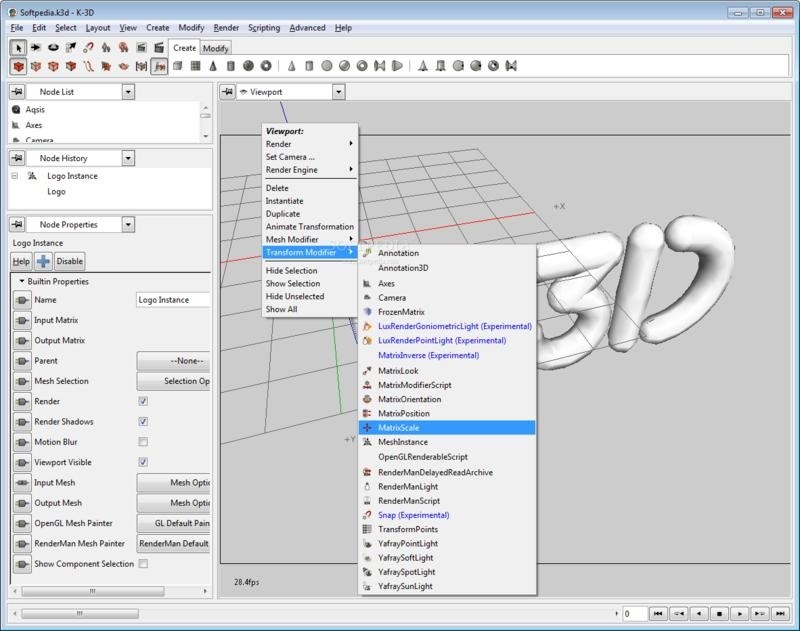
Being a flexible and powerful tool for 3D artists, K-3D combines cross-functional plug-ins with the visualization of pipelined architecture. It allows users to create their 3D models organically or via parametric workflows. The system is free from non-reversible mistakes: you can return to the original model at any moment, no matter how long you’ve been editing it. Such an advanced undo/redo option is very important for novice modelers, who frequently make thoughtless steps.
With K-3D, you can build 3D models from basic geometric figures and edit them in accordance with your needs. Its versatile instruments will let you juxtapose unexpected shapes, getting, as a result, the combinations never seen before. If you don’t like the outcome you have – simply return to the beginning of the editing workflow, modify the model, and watch the changes to develop automatically till the end.
The software of K-3D supports different formats: .obj, .gts, .raw, .jpeg, .png, .tiff. In order to extend the functionality of the software, you can download and install a number of plug-ins.
Wings3D
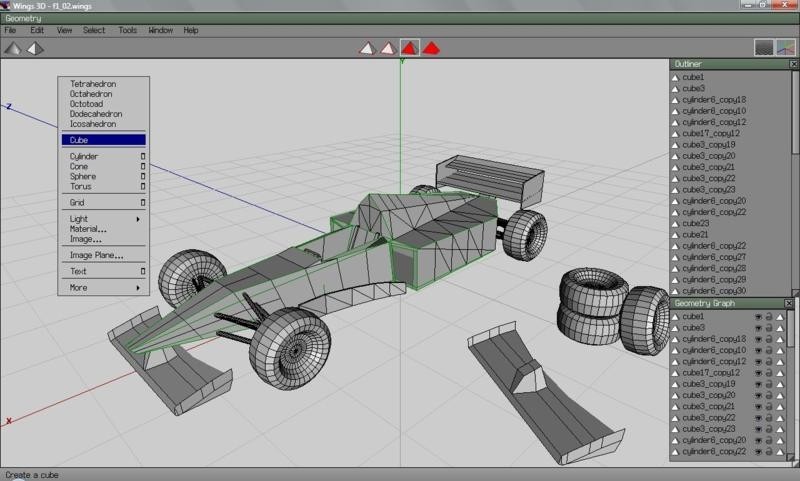
The core advantages of this software are its intuitive interface, a wide range of customizable tools, and an integrated AutoUV mapping facility. The software is suitable for both beginners and seasoned 3D artists. With its immediately available commands, brief descriptions for different instruments, and adjustable hot-keys, Wings3D is highly appreciated all over the world.
The workbench of the system includes basic tools for scaling, moving, rotating, cutting, welding, and extruding digital objects of all shapes. There are also advanced instruments, such as plane cut, bend, circularize, and sheer. Wings3D features a virtual mirror for symmetrical modeling and provides tweaking and sculpting options for a more detailed design.
Ready files are imported into .ndo, .al, .fbx, .lwo, .eps, and other formats. It is totally free of charge. Supports Windows, Mac OS X, and Linux.
Enterprise-grade
Siemens NX
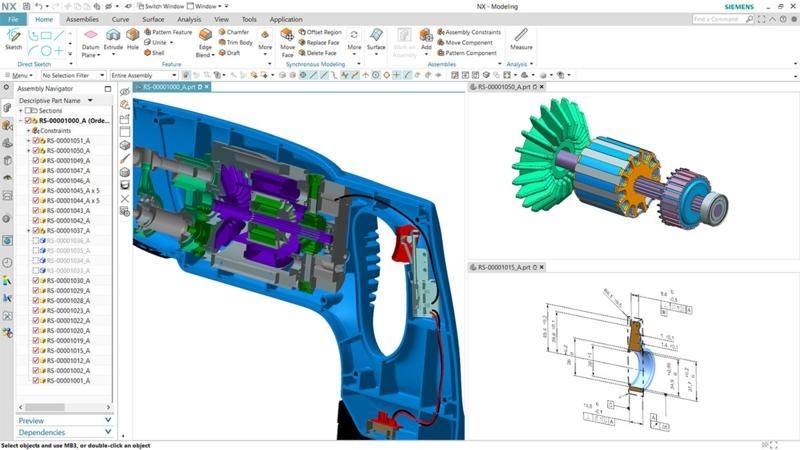
It is an industrial-level software package that covers all the steps of modeling and printing process. The product satisfies most of the needs existing in the spheres of automobile manufacturing and aerospace construction. Siemens NX supports solid, parametric, direct, and surface modeling. Its users can implement a broad range of instruments for 2D and 3D designing, creating and manufacturing technical details within the same system.
The software has a number of modules for the development of complex assemblies required in different areas of large-scale industry. Siemens NX is an ultimate solution for industrial-level purposes. For amateurs, the software may seem too complicated and expensive.
SolidWorks
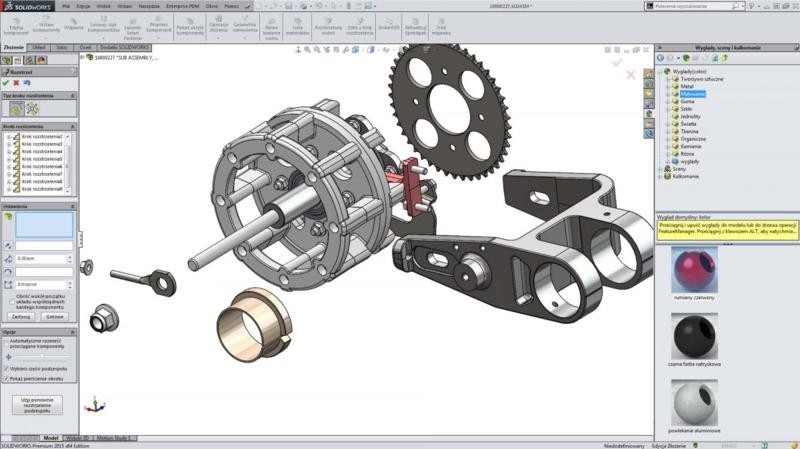
SoldWorks is applied in a wide array of industries, including theoretical engineering, nautical architecture, industrial engineering, equipment facilities manufacture, and many others. Being a solid CAD and CAE 3D modeling system, it is aimed at professionals from different spheres with advanced skills in engineering.
The product is comparatively low-cost, yet powerful and functional. It lets users create, design, modify, and, finally, manufacture a variety of technical details. Every model is checked for weak sides and safety issues. There is a library of materials, such as metal, wood, glass, and so on. The selection of modeling tools is also impressive – and all of them are designed to meet the needs of professional users.
Inventor
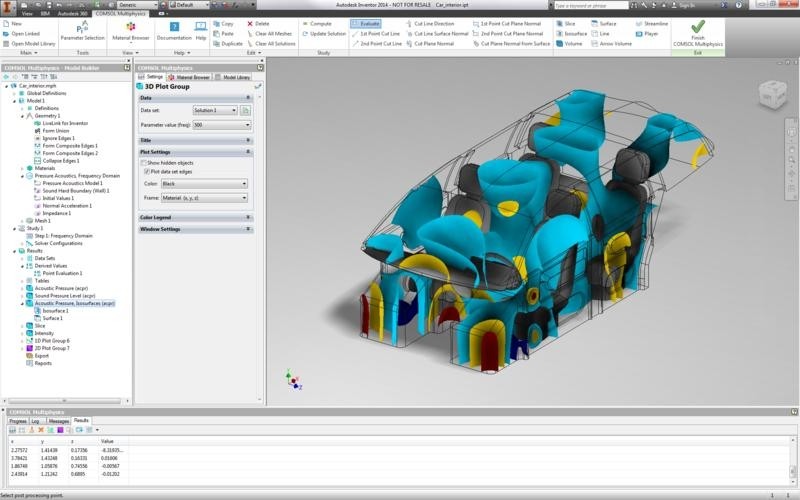
This Autodesk’s software package is aimed at the creation of digital mechanical solid prototypes. Specialists from different spheres – from medicine to vehicle manufacturing industry – apply to Inventor for the purpose of building visual models of products before they are constructed. It lets specialists avoid possible mistakes and select the most efficient mounting pattern.
The product is also great for individual 3D designers, who are skilled enough to work with industrial-level printing systems. The users of Inventor should have deep knowledge of engineering as well.
The software is compatible with Windows and Mac. It supports the formats .3dm, .ipt, .nx, .prt, .sldprt, .stl, .xgl, and others.
Fusion 360
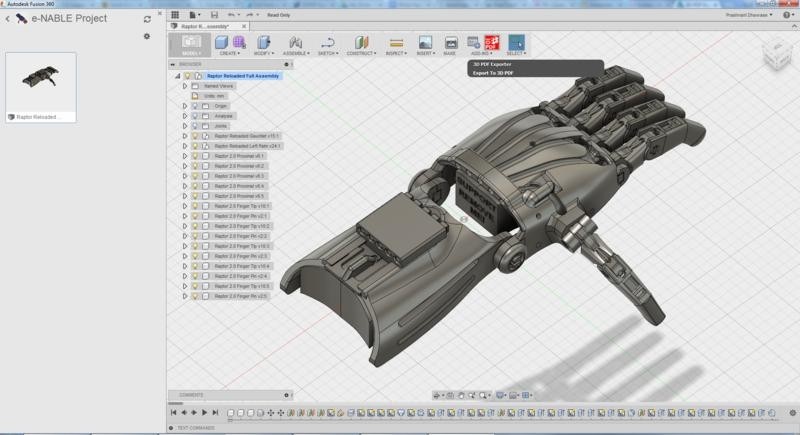
It is one more Autodesk’s product focused on the creation, improvement, testing, and manufacturing of high-quality industrial-level elements. The software allows users not only to construct the necessary details, but also to simulate the stresses they will face in the process of everyday use. All this helps engineers avoid possible issues and construct really top-end mechanical element for a wide range of purposes.
The toolkit of Fusion 360 includes powerful parametric instruments and analytical tools for mesh processing. The software supports the systems of cloud-based file sharing and version management. It lets users import and export files in all common CAD formats.
CATIA
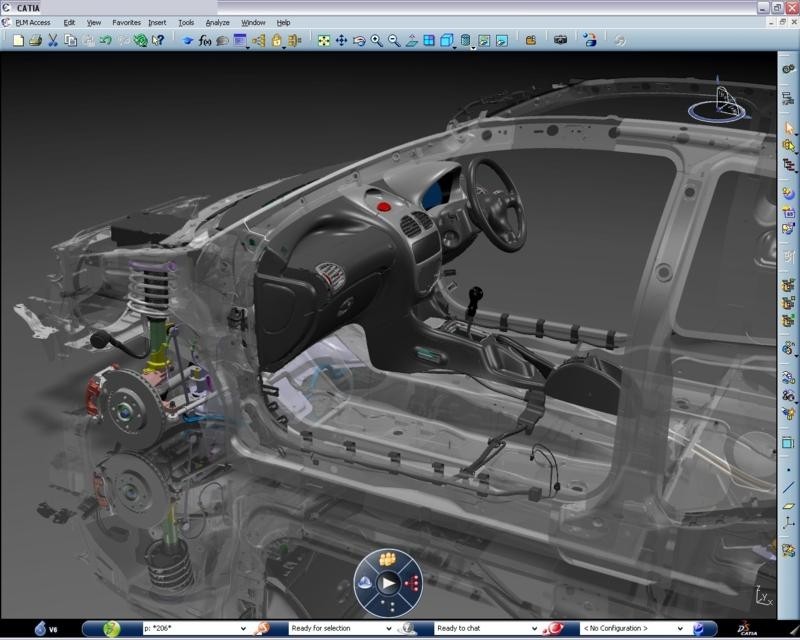
The name of this software package is an acronym for Computer-Aided Three-Dimensional Interactive Application. It is a multi-faceted software suite including the 3D CAD program, the CAM product, and the CAE solution. Built using the C++ programming language, the system of CATIA is widely applied in engineering science, industrial design, shipbuilding, architecture, and so on.
The product is designed to meet the needs of professionals, who want not only to construct a 3D element, but also to work out its interactions with other technical details, everyday pressures, possible weak sides, and so on. With CATIA, engineers, designers, and other specialists from different spheres develop more precise, safe, and reliable mechanical objects for a wide spectrum of purposes.
AutoCAD
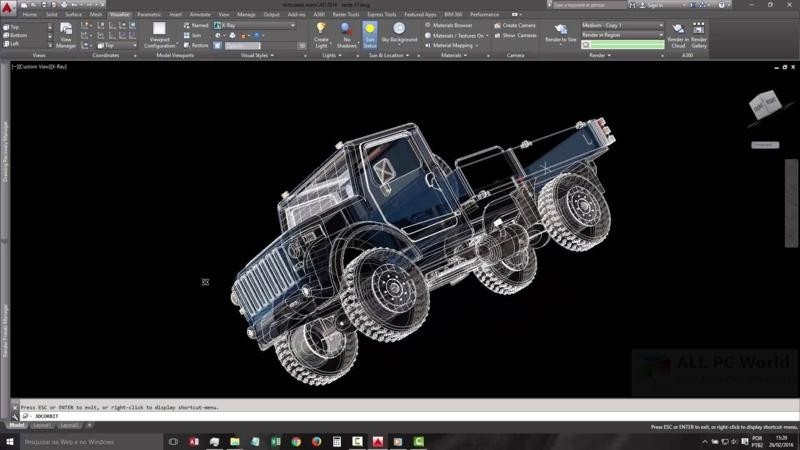
AutoCAD is frequently referred to as the great-grandfather of digital modeling software. Focused on the creation of 2D and 3D CAD images, it is available both as a desktop application and as cloud-based software. The product is used by many professionals from the spheres of architecture, project management, engineering, graphic designing, and so on.
As distinguished from many other enterprise-level 3D modeling solutions, AutoCAD is suitable for beginners and amateur designers, who require extensive training. It lets users construct and modify their digital objects with a wide range of instruments, from simple to professional-level. With AutoCAD, you can easily grow up from a novice 3D hobbyist to a seasoned model-maker.
Slicing and 3D Printer Hosting
In order to print a 3D object, you first need to create a mathematical description of the model and then this information needs to be be transferred to the printer. The objects should be divided into layers - transferred into G-code - so that the printer can recognise the description and print out the model. This is exactly what 3D slicers do: they slice objects into layers, which are then printed out as a 3D model. The slicer software creates the G-code, which contains all of the printing parameters.
In many cases, the quality of 3D models depends even more on the slicer than on the 3D printer itself. For this reason there are quite a few different 3D slicers to choose from, both free and pricy. In this section of the article you can learn about some slicer software, find links for downloading and informational videos. We will also include some programs that can will allow you to operate your 3D printer with utmost effeciency.
For beginners
AstroPrint

AstroPrint is a cloud-based in-browser 3D printing solution, not unlike 3DPrinterOS, with a free version. It works as a slicer but can be used for other processes. Being web-based, it allows users to monitor and manage production using a mobile app or a web browser. Free AstroPrint Cloud account is enough for most users.
The software is optimized for working with 3D printing sharing platforms, such as Thingiverse, it also supports working with CAD software. The built-in slicer can be used remotely from any device with Internet access. AstroPrint supports large-scale networks and can be used by businesses and manufacturers.
CraftWare
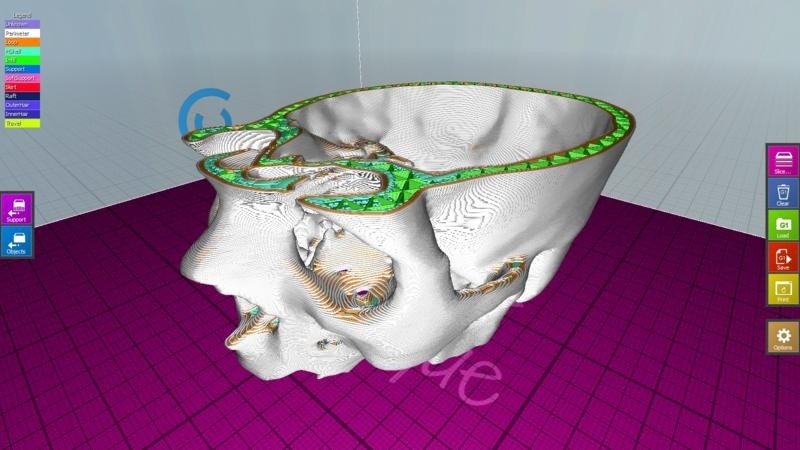
CraftWare is a free and cross-platform slicing solution developed by the 3D printer manufacturer CraftBot. It’s compatible with other printers, actually with almost any FDM printer on the market. The functionality is noteworthy: there’s a G-code visualizer and the ability to view prints on the layer by layer basis. The developers claim that the slicing algorithm is very advanced, and they seem to be telling the truth. The software also supports print management and simplifies the printing process.
The interface is intuitive, bright and colorful. CraftWare is suited for both beginners and experienced users.
Cura
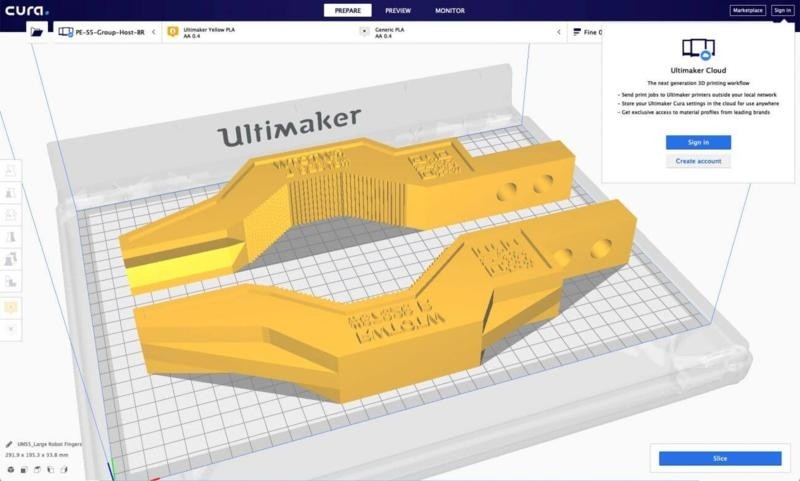
Cura is an open-source and cross-platform slicer software initially used for Ultimaker 3D printers. It's not limited to the brand's devices and can be used with other 3D printers, while the variety of plugins makes it much more flexible and advanced. It's very popular and one of the most recommended slicers for beginners thanks to its clear and intuitive interface. Cura can also be used as a host software for your printer, provided the latter is connected to PC while the software is in use.
There are 2 modes available:
-
Recommended (simple) is a mode for beginners, it will allow you to quickly start using the software.
-
Custom — a preferred choice for experienced users, it allows manual adjustment of hundreds of different settings with flexible and precise control over them. There is an ability to save different profiles, depending on your printer and workflow.
The Cura community is large and there are many tutorials available.
KISSlicer

KISSlicer (Keep It Simple Slicer) is a cross-platform slicer software with a free version (which supports printing with only one extruder). Despite the name, KISSlicer is rather complex and has a wide variety of functions. Many complain about its interface that is considered confusing, so the software isn't usually recommended for beginners.
KISSlicer is regularly updated with new features, and there's a decently-sized community on the user forum.
Combined with the ability to give users precise control over the printing process and being heralded by some as the best free slicer on the market, it's not hard to choose this software. Its interface might be far from intuitive and the settings are complex but it's a free to use slicer with an impressive amount of features that are constantly updated and refined.
Simplify3D
Simplify3D supports most desktop 3D printers on the market, regardless of the number of extruders and other construction features. If you happen to have a printer that is not on the list, you can manually adapt the program.
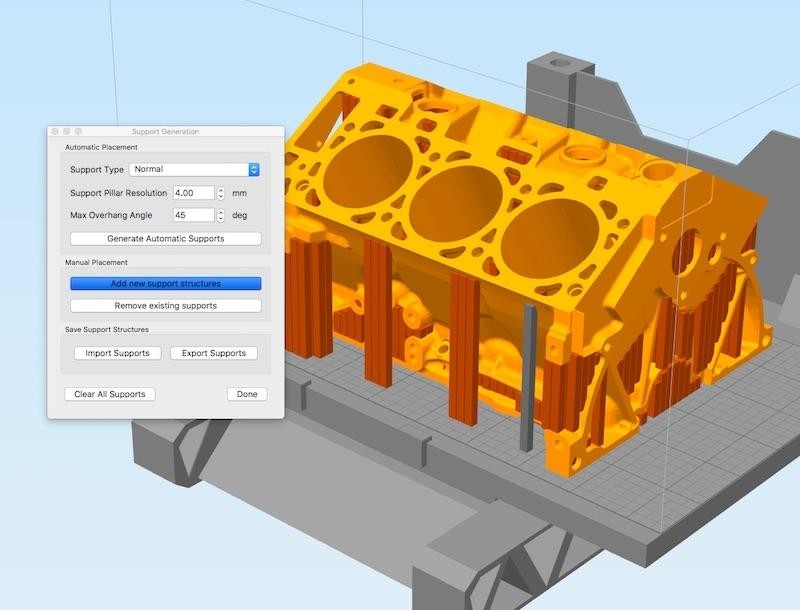
It is possible to quickly and conveniently edit your 3D models in the program. This software offers a ton of settings that you can play around with: extruders, layer control, various infill methods, temperature, and cooling settings, even G-code and scripts can be edited.

There can be several “Processes” in one single printing task - different models or parts of the models with varying settings, such as wall thickness or infilling. This feature allows users to print several different 3D models simultaneously.

Characteristics: Overall, Simplify3D is a highly advanced software for 3D printing that can satisfy all of your needs. This means that paying a little extra is completely worth it.
- OS: Windows, Mac OS.
- Price: $150 for a 2-computers license.
Simplify3D demo video:
Craftware

Craftware is a 3D slicer software, developed by a Hungarian 3D printer manufacturer CraftUnique. Initially, it had been designed only with CraftBot 3D support.
CraftBot 3D Printer
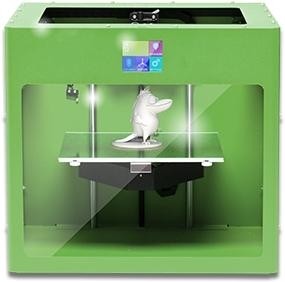
Despite its compact construction, CraftBot 3D printer is capable of printing objects up to 250х200х200 mm in size. The device is sold in the assembled condition and is available in a variety of colors.
The key features are:
- OS: Windows, Mac, Linux
- Materials: PLA, ABS, Nylon
- Filament diameter: 1.75 mm
- Nozzle diameter: 0.4 mm
- LCD display: 2.8 inches
- Minimum layer height – 50 micron
Today, Craftware is compatible with other brands of 3D printers as well. This software, like the majority of 3D slicers, offers two operating modes: “simple” and “expert”. Craftware has an intuitive interface and a great G-code visualizer where raft, support materials, layers, and infill are presented in different colors. You can work with the basic set of features, or choose from more than 300 settings in the app’s catalogue.

CraftWare operation screen
Craftware gives its users an opportunity to view each print layer-by-layer from every conceivable angle, which makes it easy to spot all of the model imperfections and fix them right away.
Characteristics: The main feature of this slicer is the ability to operate the individual components of the model. The only other slicer, which can offer a similar feature, is a $150 software Simplify3D. CraftWare has a very convenient and user-friendly interface that is also quite fast. In addition to that, users have an opportunity to view how settings alterations affect the model at the stage of development.
- OS: Windows, Mac, Linux.
- Price: free.
CraftWare demo video:
MakerBot Print

MakerBot Print is a dedicated software, developed to work with MakerBot 3D printers, hence the name. This program automatically adjusts slice settings for the specific mode and extruder type of your MakerBot printer.
Characteristics: MakerBot offers a feature, which is similar to OctoPrint software: it is possible to remotely control your 3D printer via the Internet and monitor the operating process using a webcam. You can read about OctoPrint further in the article.
- OS: Windows, Mac.
- Price: Free.
MakerBot Print overview:
Z-Suite

Z-Suite operation screen
Similarly to Tinkerine Suite, Z-Suite was designed for 3D printers of a specific manufacturer - in this case, it’s Zortex.
Characteristics: This software has quite a limited editing feature set, which will allow you to alter and repair your 3D meshes. That being said, the program enables auto analysis of the model and is capable of identifying parts of the model, which may potentially cause troubles in the printing process. More than that, Z-Suite makes it possible to operate your 3D printer remotely.
- OS: Windows, Mac.
- Price: Free.
Z-suite demonstration video:
Intermediate
3DPrinterOS

3DPrinterOS is a cloud-based cross-platform 3D printing software with a free to use package (Starter package). That version already allows users to monitor printing remotely, to work with G-code and toolpaths, gives forum access among other things. There's a $15 version with many additional features and even more expensive business versions, but we will not talk about them in this article.
3DPrinterOS has an in-cloud slicing that simplifies the process significantly. There's also an in-app plug-in system that makes the abilities of the software much more advanced.
But 3DPrinterOS is more suited for enterprises and businesses and there are better and simpler solutions for home printing (especially for complete beginners). Nevertheless, the free package is worth a try.
OctoPrint

OctoPrint is a free and open-source web-based host software that grants users extremely precise control over the printing process. Its web interface can be used to remotely control WiFi-enabled device (for example, single-board computers such as Raspberry Pi) that is connected to a printer.
It accepts G-code from almost any existing slicer software and is able to visualize the files at any stage of the production. OctoPrint itself can function as a slicer, successfully eliminating the need for multiple solutions.
The software can be set up to send push notifications or alerts to users via messaging apps, which makes controlling your printer remotely even easier.
Not only does OctoPrint provide users with a plethora of tools to control the printing process remotely, but it also offers several ways to keep track of print jobs in progress. Users can set up Octoprint to send push notifications or have alerts sent to them via various messaging apps.
There's an active community around OctoPrint, and a plug-in system can make the software even more flexible than ever.
Repetier-Host
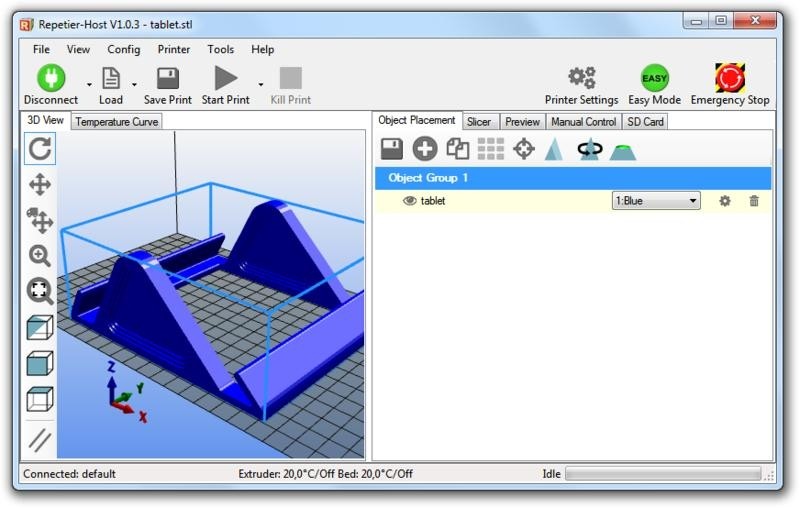
Repetier-Host is a free and open-source cross-platform 3D printing software, one of the oldest on the market. It's often recommended by the RepRap community,
It's an all-in-one solution, acting mainly as a host but compatibility with different slicers and the ability to act as a slicer itself make it great for other things. There's also multi-extruder support for printing with up to 16 heads. The software is also capable of allowing users to remotely monitor and control the productions (via Repetier server).
It's a very comprehensive and multifunctional piece of software, but it's not recommended for beginners.
MatterControl 2.0

MatterControl 2.0 is a free and open-source cross-platform all-in-one 3D printing software. The functionality is pretty wide — MatterControl 2.0 covers all the stages: you can design 3D models, slice STLs and export them for offline printing, as well as use the software as a host.
The interface is clean and not bloated despite the sheer amount of functionality that MatterControl 2.0 provides. It allows users to design 3D parts, then seamlessly transfer them into the slicer and print them, while having significant and precise control over each stage of production.
The software is also beginner-friendly but obviously it's also recommended to experienced users (especially the ones that prefer to use all-in-one packages instead of multiple solutions).
Netfabb Standard
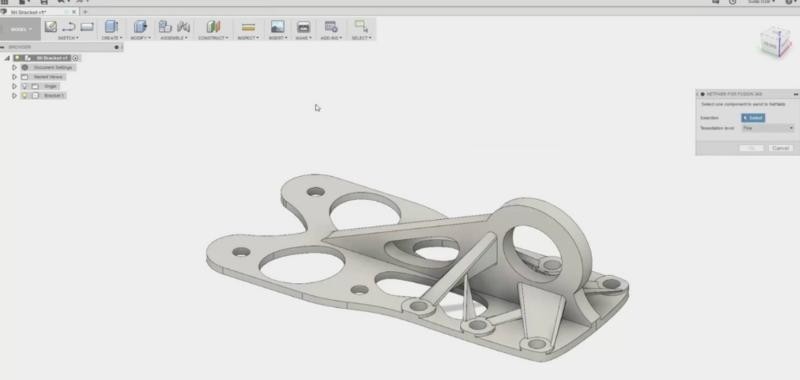
Netfabb operation screen
Netfabb is a very powerful, but costly tool that makes it possible to analyze, repair and edit STL files. It was initially designed as free software, but with the addition of more advanced features, developers put a price on it.
Since 2015, when Autodesk acquired Netfabb, the application has been divided into four products: Netfabb Standard, Netfabb Premium, Netfabb Ultimate, and Netfabb Simulation.
Characteristics: Netfabb makes it possible to edit the model, adjust wall thickness, smooth rough areas and automatically identify parts of the models that require support.
- OS: Windows.
- Price: $230 to $13135 (annual subscription)
Netfabb Standard introduction video:
Tinkerine Suite
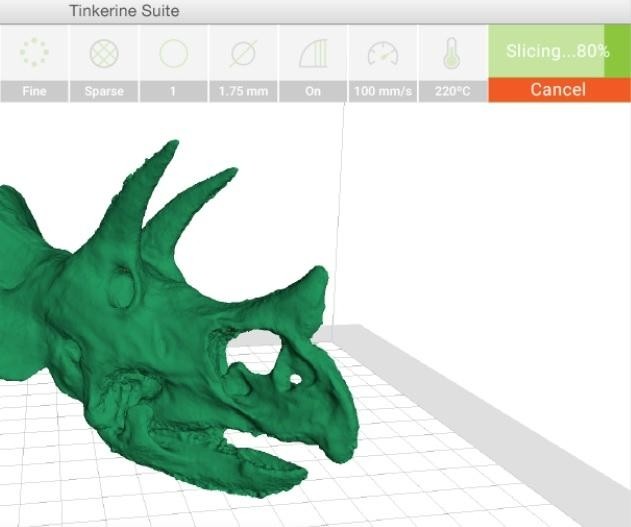
Tinkerine Suite operation screen
Tinkerine was developed specifically for Ditto and Litto 3D printers. The program is advertised as “the most user-friendly 3D slicing software”: the design is very neat and clutter-free, which enables users to configure printer settings quickly and efficiently. The software offers the basic 3D editing tools, and is capable of creating supports and preparing models for printing. In addition to that, it is possible to calculate the printing time.
- OS: Windows, Mac.
- Price: Free.
Tinkerine Suite demo:
ideaMaker
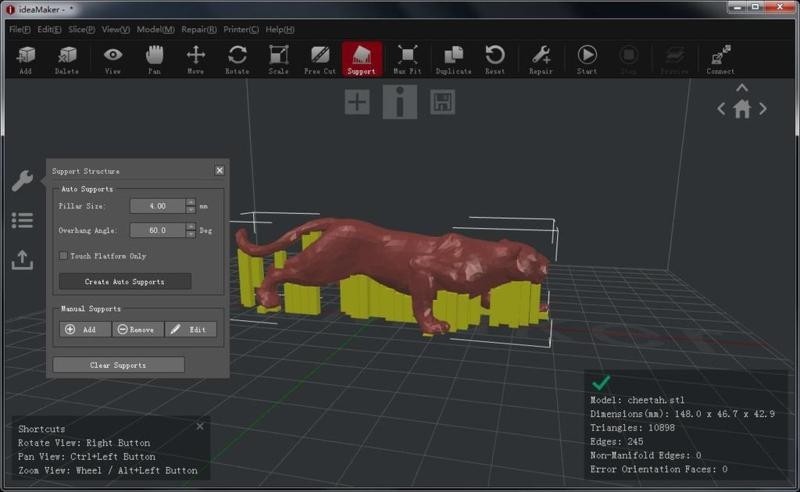
ideaMaker is a free cross-platform slicer software developed by the 3D printer manufacturer Raise3D. It can be used with most 3D printers on the market and greatly simplifies the slicing process. It can also function as a repairer and a 3D printer hosting software, which can be quite handy. The interface is clear and intuitive and the functionality is pretty good: auto-layout for multiple files, automatic support generation, and there is a flexible plug-in system that allows you to extend the limits of the software.
It's a great choice for both beginners and experienced users, and the software is regularly updated. Its user forums might be less active than the ones for more popular slicing solutions but are still very helpful.
Professional
IceSL
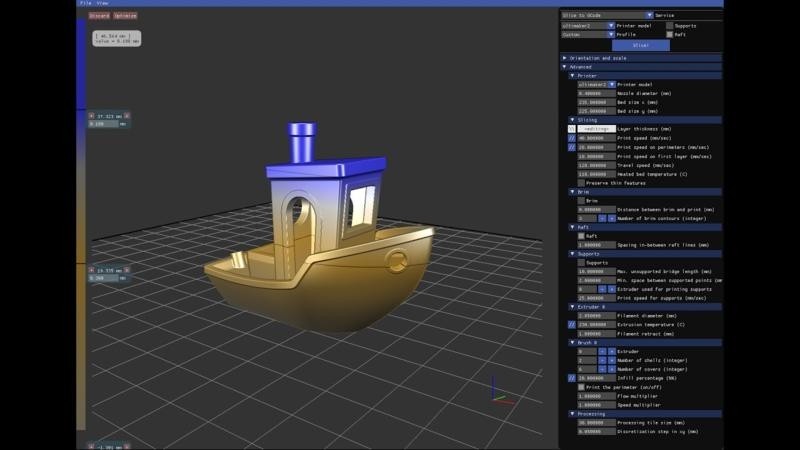
IceSL is free to use 3D printing software available for Windows and Linux. It combines the functionalities of both slicer and 3D designing software. It will even allow you to quickly edit models using scripts in a Lua-based language. The live preview is included which makes the process a bit more intuitive.
Some of the settings are preconfigured for beginners with IceSL tweaking the others automatically. Experienced users might want to delve deeper into the settings and the software easily allows it. There are many interesting tricks and cutting-edge technologies to use.
Slic3r

Slic3r is an open-source and cross-platform 3D slicer solution.
It's relatively rarely updated but somehow Slic3r manages to have cutting-edge features that the competition lacks. They include brand new infill patterns and support for many different types of 3D printers. Slic3r is open source, so there are forks that are based on this software. For example, Slic3r Prusa Edition is optimized for Prusa i3 series of 3D printers. Slic3r also supports direct integration with Octoprint software.
And last, but not least, there's a community support, and a detailed official manual can be found on the Slic3r website.
SliceCrafter
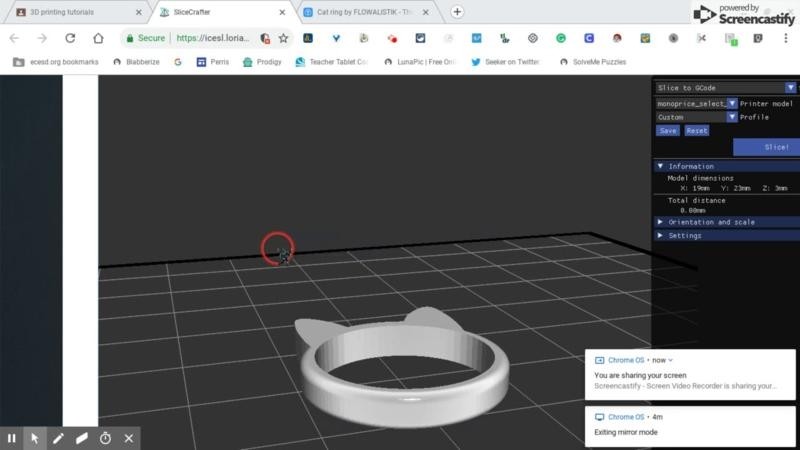
SliceCrafter is a web-based slicing solution made by the developers of IceSL. The interface is as simple as it gets — a browser window will allow you to quickly upload STLs, preparing G-code is quite intuitive as well.
It's a good software for beginners but it's just not powerful and flexible enough for some experienced users, even the developers admit that fact.
PrusaSlicer

PrusaSlicer operation screen
PrusaSlicer is an open-source 3D slicer software with a wide array of outstanding features and hundreds of different settings to fiddle with. This program is compatible with both FDM and SLA/DLP 3D printers, which makes it quite a unique application.
Like the majority of 3D slicers, PrusaSlicer offers three user modes which make the app transparent and convenient for users of any skill level. In addition to that, this software has a massive user community, who create and share their own plugins and addons which extend the program’s feature set even further.
Characteristics: The software is a must-have for Prusa printer users. PrusaSlicer has three user modes for different degrees of skill. The app has a very user-friendly interface that is quite easy to navigate. This program enables model repair via Netfabb online services, offers custom supports and precise calculations of the printing time.
- OS: Windows, Mac, Linux
- Price: Free
PrusaSlicer overview:
Animation Software
3D animation is a large discipline and a complex art, which requires a wide variety of skills, from understanding of 3D models to knowledge of framing, shot composition, and sometimes even anatomy. And that is not the whole list of things you need to know. Some people spend decades perfecting their abilities in animation, there are long educational courses and there are big industries based around it. 3D animation is extensively used in video games, movies, TV shows, music videos, engineering and small hobbyists projects. But obviously without software, 3D animation as we know it would not exist.
In this section of the article, we’ll tell you about the best 3D animation software you can get in 2020.
3D Animation
3ds Max
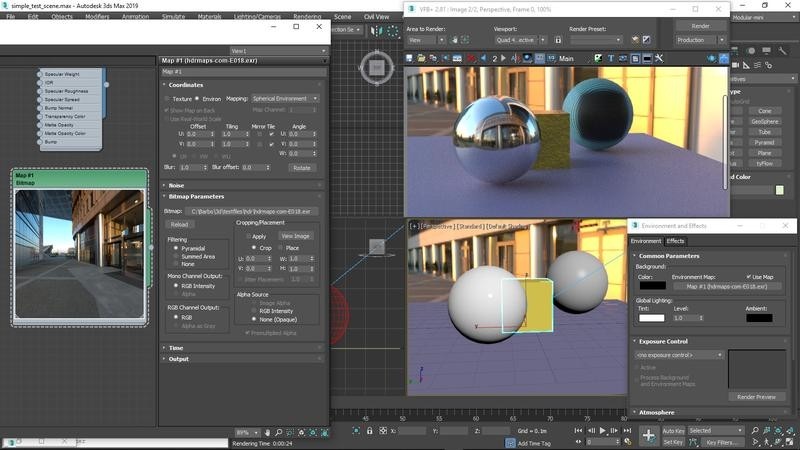
Application: Motion Capture, Keyframe Animation
OS: Windows
Formats: stl, 3ds, ai, abc, ase, asm, catproduct, catpart, dem, dwg, dxf, dwf, flt, iges, ipt, jt, nx, obj, prj, prt, rvt, sat, skp, sldprt, sldasm, stp, vrml, w3d xml
3ds Max developed by Autodesk is probably the most popular 3D animation software on the market. It’s available for Windows and is a paid software (and at $1545 a year, a rather expensive one) but the free trial is available. It’s used across the whole industry for various purposes: designing video games’ assets and creating animation, VFX in movies and TV shows, architecture, engineering, interior, as well as landscape design and construction.
The feature set is extensive: for 3D rendering, there is the ability to design parametric and polygonal models, the ability to create models from point cloud data, various ways to simulate particles, clothing, and lighting. There’s even a proprietary scripting language called MAXscript.
However, this section of the article is devoted to 3D animation, so we are going to talk about the wide range of animating features that 3ds Max has to offer. The CAT (Character Animation Toolkit) will allow you to design, change and animate non-bipedal characters. For humanoids and other bipeds there is a toolkit named “Character Studio”. Both can use the impressive “Motion Mixer” tool that looks quite similar to video and audio editing solutions: It displays separate tracks that can be edited, granting you the full control over speed and order of animated movements. Those moves can be transitioned, looped, played backwards. For controlling scenes with large crowds there’s a tool called “Populate” that makes things easier – for example, it can automatically fill the scene with many people.
Another useful feature is “Motion Paths” which provides demonstrative viewpoints and editing capabilities for the trajectory of motion of your models using splines, which can be quite handy and can help saving some time planning the paths of the objects.
The V-Ray rendering is also available via a plugin.
Watch the official animation tutorial here:
Blender
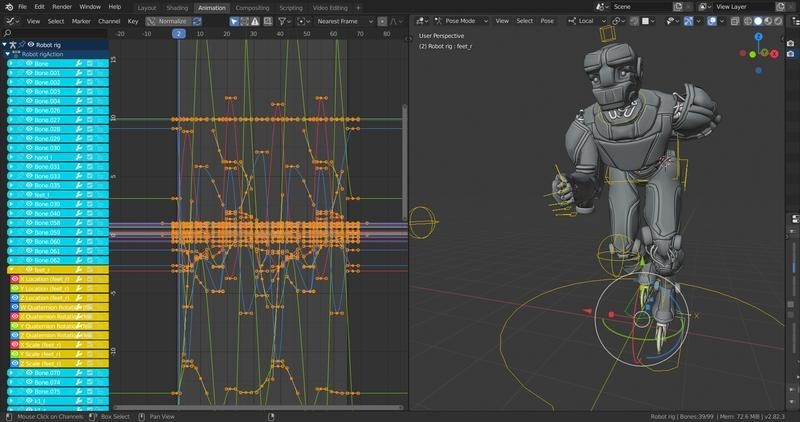
Application: Motion Capture, Keyframe Animation
OS: Windows, macOS, Linux
Formats: 3ds, dae, fbx, dxf, obj, x, lwo, svg, ply, stl, vrml, vrml97, x3d
Blender is a cross-platform free and open-source 3D animation and modeling software. It's popular and has great community support. It's used for VFX, animations, video games, and engineering, it can even function as a CAD software for 3D printing enthusiasts. Not only professionals use it, it's also quite popular among the hobbyists thanks to being completely free. The complete set of features might fill a few paragraphs, but the main points are its own rendering engine called Cycles, that allows a complex path tracing used in lightning, hair simulation, soft body simulation, smoke and fluid simulation, physically based rendering. There are interesting camera effects: depth of field support and stereoscopic rendering. Other than that, Blender can be used for sculpting, compositing, video editing and even used to have an integrated video game engine that supported Python scripts (it was removed ahead of the launch of 2.8 version).
Regarding 3D animation tools, there are impressive features and abilites as well. There is rigging – the ability to design layers of bones and the whole skeleton of the character, which allows you to define the mobility of body parts and simplifies making the character posable. Non-linear animation is also supported. Other features include lattice modifiers, support or input from motion capturing programs, camera and object tracking, inverse kinematics. Motion Paths are available as well and help to get a clear view of the path that your objects are gonna follow.
If all of the above not enough, Blender’s abilities can be extended via plugins and scripting.
Watch this animation tutorial aimed for beginners and covering the last version:
Cheetah3D
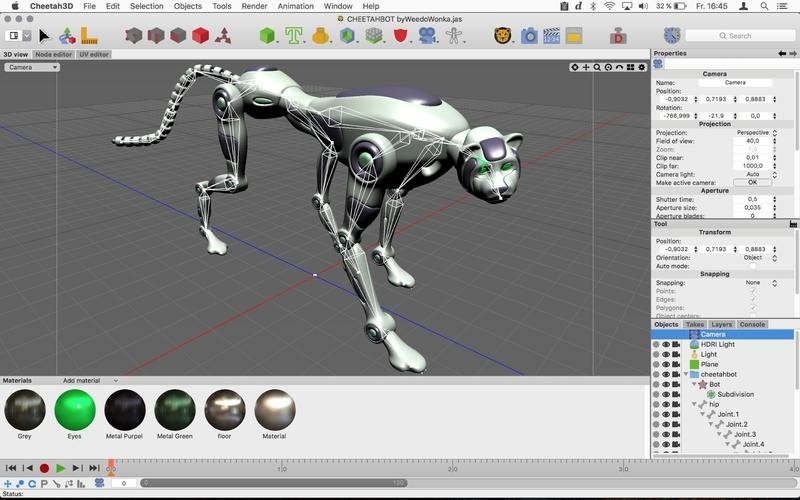
Application: Keyframe Animation
OS: macOS
Formats: 3ds, dae, dxf, fbx, obj, sia, stl, jas
Cheetah3D is a paid (rather inexpensive at $99) 3D editing and animation software available only for macOS. The free version (without saving and exporting features) is available as well. It’s aimed towards beginners and those who want a simple task done with ease and without spending days doing simple editing, rendering and animation. Gladly, a clean interface and a really simple layout with several automatic features make all of the above possible. Speaking of interface, the program praises itself as being developed natively (and only) for macOS, so everything is designed with macOS’ UI guidelines in mind. Everything developed under the surface is obviously optimized for ‘Macs’ as well.
But being easy to use, recommended for beginners and nice-looking does not make the program in any way limited functionality-wise. The feature set is impressive: for rendering there’s an OpenGl preview and multi-threaded rendering (up to 18 CPU cores). Ray-tracing is fully integrated into the rendering engine, and all of the important polygonal modeling features and tools are included in the software. The models can be rigged (Cheetah 3D is no match for serious rigging software but it’s more than enough for many enthusiasts) and prepared for animation.
The keyframe animation is supported and almost everything can be animated. Rigging will be handy to help to move the body parts of your characters. There are several interpolation types that will be useful for filling up the missing frames. Heat weighting and both forward and inverse kinematics are supported. Anchors can connect soft and rigid bodies. Mesh vertices and spline control-points can be animated as well.
Here’s a good and illustrative (even though a bit dated) tutorial covering the basics of the animation process in Cheetah3D:
Cinema 4D
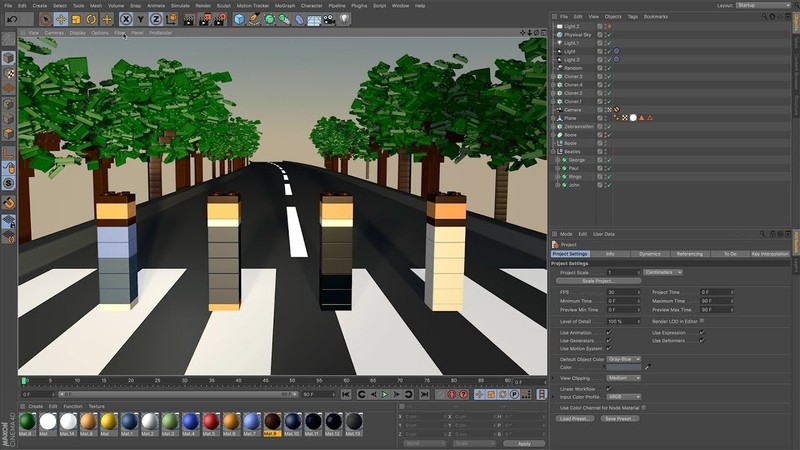
Application: Motion Capture, Keyframe Animation
OS: Windows, macOS
Formats: 3ds, dae, dem, dxf, dwg, x, fbx, iges, lwf, rib, skp, stl, wrl, obj
Cinema 4D is a paid 3D modeling, rendering and animation software available for macOS and Windows. It’s a powerful tool actively used in movie and television industries among VFX professionals and motion graphics artists. Despite that, the interface is clean and intuitive. It’s really simple to pick up the program and start working, the learning curve is not steep, especially for those already experienced with 3D animation.
Features include the ability to preview renders, various camera, and visual effects and deep integration with Adobe After Effects. Interesting 3D modeling features include the BodyPaint tool that will allow you to easily edit textures of your models and the Character Object tool simplifies rigging the characters. The real-time viewport is based on OpenGL and various rendering engines supported via the plugin system. The rendering speed can be increased with the LOD tool that changes the detail of the objects based on their proximity to the camera.
The animation abilities are extensive, there are several tools that help to make your characters move. The Cmotion system, for example, allows you to set up cyclical movements (walking, running) with a parametric solution. There are forward and inverse kinematics. You can set up and control facial expressions with sliders, the muscle, as well as skeletal and joint systems make motions much more natural. There are ways that help controlling interactions between the models, and you can precisely control the weight painting overflow. Various features simplify the integration of live footage with 3D animation objects. The Scene Reconstruction tool creates colored point clouds from tracked features.
Watch this animation tutorial, covering the rigging process:
Daz Studio (Daz3D)
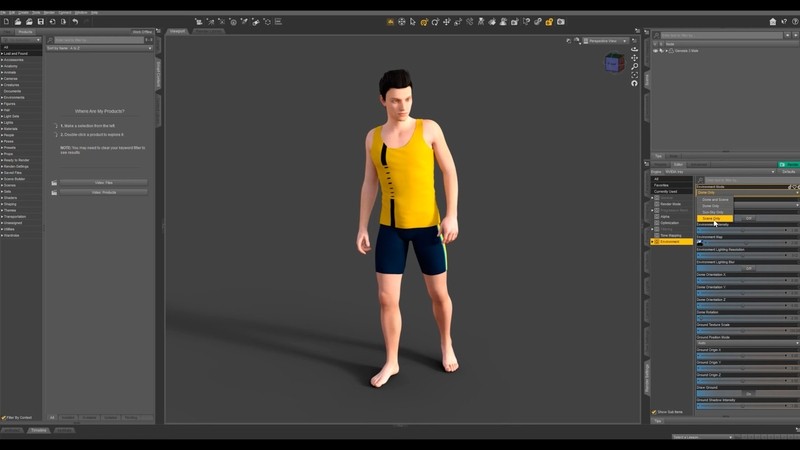
Application: Motion Capture, Keyframe Animation
OS: Windows, macOS
Formats: obj, fbx, dae, daz
Daz Studio is a free 3D animation software available for Windows and macOS. Due to being aimed at hobbyists, it tries to simplify the process and ease the workflow whenever possible. There’s a marketplace of the models that you can buy (it’s the main source of financial support for the developers) or you can modify a preset 3D model from the library. But 3D designing isn’t the main point of this software, its focus lies in the animation and working with the motion capture data.
The Puppeteer feature allows you to quickly work with different poses for your model using only a mouse. The program can even interpolate the motions between the poses automatically which significantly simplifies the animation process.
The aniMate 2 tool (can be downloaded as a paid plugin) designed for human movement also makes the animation much easier.
The software uses a keyframe animation and supports HDR lighting among other advanced features.
It’s a good choice for a beginner and the 3D Content Marketplace provides a lot of models and poses for those willing to simplify their work even more. Paid and free plugins are also available.
Watch this animation tutorial to understand the basics:
Houdini

Application: Motion Capture, Keyframe Animation
OS: Windows, macOS, Linux
Formats: bgeo, clip, fbx, geo, hip
Houdini is a paid (but there is a free version called Houdini Apprentice geared towards those who want to learn the software without paying for it) 3D design and animation tool. Widely used in VFX, it has enough reputation for some to predict that it will soon become an industry standard in movie productions. It uses procedural modeling workflow based on nodes (individual parameters of models) – that means that after several parameters have been set, the program semi-automatically generates objects based on a certain algorithm. The approach allows you to quickly alter entire models and create complex geometries. Almost everything can be procedurally generated in Houdini, and it also simplifies reusing the models (a few tweaks can alter the object significantly).
Animation features are extensive: everything can be easily animated using various tools and solutions that the software offers. Big crowd simulations can be precisely controlled with the ability to set the collision avoidance and crowd’s layout. There’s a built-in muscle simulation pipeline that can be used for character animation (both bipeds and quadrupeds can be animated) and there’s an automatic rigging tool provided by the software.
But the most important and ‘killer feature’ of Houdini is the use of simulations. It makes it the choice for VFX artists in a wide range of industries. Fluid, fire and smoke and particle simulations are impressive, outshine most of the solutions offered by the competition, and can as well be procedurally simulated.
There are different versions of Houdini and their prices vary. There is a free version called Houdini Apprentice (mentioned in the beginning) that is good for learning and has all the tools available albeit somewhat limited. There is an educational license that usually costs around $75 per year, aimed at school students and teachers. For the small studios that make less than $100,000 a year, there’s a Houdini Indie available at $269 (it’s ‘node-locked’, meaning one instance can only be ran at one computer). For big studios, professionals and other enterprises there is a variety of different licenses running from $1,995. Different options are available, some licenses are free and only allow working with core functions or exporting the assets into the other apps. So far the most recommended for beginners version is Houdini Apprentice due to being free and having enough features that help to use some of the software’s powerful tools and master the skills.
Here’s an illustrative tutorial that shows how to disintegrate the geometry into particles:
iClone

Application: Motion Capture, Keyframe Animation
OS: Windows
Formats: 3ds, bvh, fbx, obj, vns, skp
iClone is a paid ($199 and sometimes goes on sale) character generation, motion capture, and 3D animation software. It’s pretty easy for beginners, the interface is intuitive, the learning curve is short, and generating the characters has never been easier – they are based on a base mesh that is morphable. Using a toolset that allows you to edit their bodies in a large variety of ways makes the process even easier. There’s a library and a marketplace that can help with the characters’ features. Your bipeds are automatically rigged as well.
Speaking of animation, there’s an option to use a keyframe animation or get a motion capture data using Microsoft Kinect. Everything is intuitive and effortless. Preset layouts also help significantly. Combine that with a powerful motion editor, abilities to precisely control facial animations, extensive lighting options and a built-in physics engine – and you get a pretty impressive package.
The program is inexpensive, has several interesting features, is easy to use even for complete beginners and is a good way to speed up the animation process even for the professionals.
You can watch an official scene creation tutorial here:
iPi soft
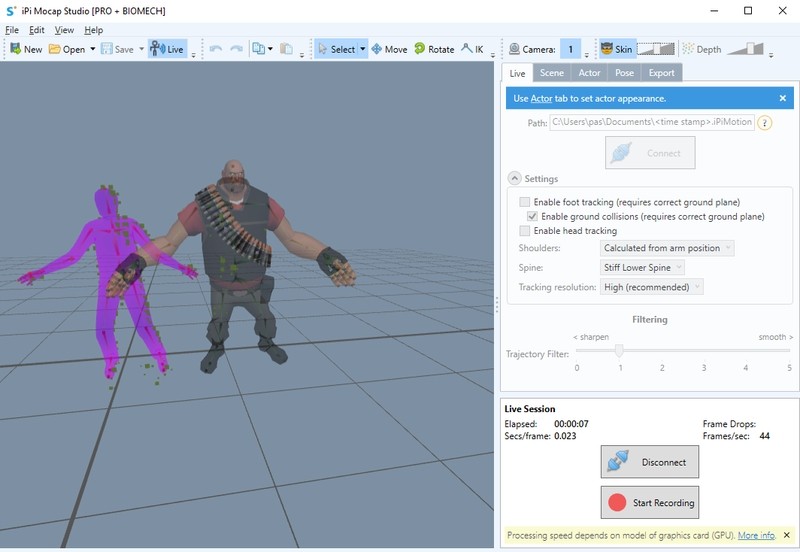
Application: Motion Capture
OS: Windows
Formats: bvh, fbx
iPi Soft is a paid Windows-only motion capture and 3D animation software. It doesn’t require wearing markers and suits and can track up to five motion capture actors. Using depth sensors such as the Kinect or Sony PS Eye cameras it can track movements in the spaces up to 7 to 7 meters. No special lighting equipment required either.
The data can be edited and popular motion capture file formats such as BVH, FBX, and Collada are supported. The results can also be exported to other 3D software such as Maya for further editing.
The cheapest license costs $195 and supports only one depth sensor, using several of them requires more expensive subscriptions. The educational discount is available, and the free trial also exists.
You can check the useful tutorial regarding iPi Soft’s abilities here:
LightWave 3D
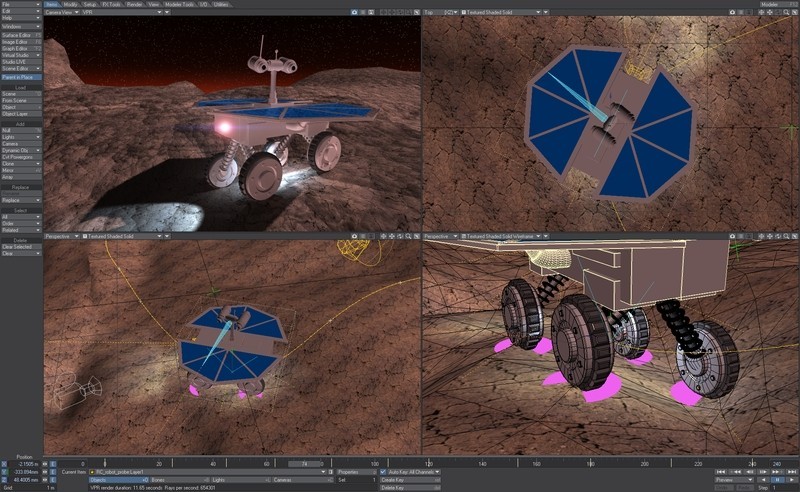
Application: Keyframe Animation
OS: Windows, macOS
Formats: obj, dxf, 3ds, dae, fbx, stl, ply
Lightwave 3D is a paid 3D editing and animation software package available for Windows and macOS. It consists of several different programs – mainly Modeler (used for designing and editing models) and Layout (it covers everything related to animation and rendering). There’s a third program called Hub that allows syncing the date between the two. Lightwave 3D is one of the oldest (if not the oldest) solutions in the world of 3D, it predates Autodesk’s programs such as Maya and 3ds Max, and it has quite a serious reputation and is widely used across the industries: movie and anime production, television, video games. Several blockbusters and classic video games (such as the first ‘Diablo’ game) used the software in one way or another.The functionality is as powerful as it would be expected from a program like that. Polygonal modeling and subdivision surfaces are supported. The shader’s features are very good: there are subsurface scattering and total reflection algorithms. There are also a powerful Node Editor and an auto-rigging system.
The animation features include inverse and forward kinematics, there is particle simulation: liquids, smoke, and fire are supported among other things. There are procedural, nodal and keyframe animation tools. Facial animations are covered by the Endomorphs sub-system. You can also make the content ready for VR and stereoscopic 3D movies.
The data can be easily exported and imported, and as a bonus there’s deep integration with the Unreal Engine.
The package costs $995 (which is still cheaper than many competitors’ solutions at the same level of functionality and popularity) but there’s a free trial available.
You can watch a tutorial covering the character animation process here:
Maya

Application: Motion Capture, Keyframe Animation
OS: Windows, macOS, Linux
Formats: ai, aiff, dae, dxf, dwg, eps, fbx, maya, mel, obj, stl
Maya is a paid (although a free trial and a free educational license exist) cross-platform 3D editing and animation software developed by Autodesk. Extremely powerful, very popular, quite expensive and significantly flexible – these words perfectly describe Maya. It has been an industry standard in movie making, video games and television for years. VFX for your favorite blockbusters have likely been created using Maya. Everyone who wants to get a serious job in the industry usually has to master this program. In other words, Maya is a behemoth of application. Not only it has a special place in the industries where it’s extensively used, but its functionality is powerful as well. The interface is highly customizable, a few shortcuts can allow you to make complex changes to your models in a few seconds. Not unlike Houdini, Maya uses a node-based workflow but is not focused on a procedural generation (but is capable of that). The compositing tool called ‘MatchMover’ allows you to composite 3D elements with the motion data of filmed sequences. There are also a particle, hair, fluid and clothing simulations and sophisticated toolsets that allow you to work with those.
As you can already guess, you can write quite a few books regarding Maya’s features, so let’s focus on the 3D animation tools. Maya is capable of auto-rigging and is quite good at it. The rigging toolset can even work with winged models and quadrupeds apart from bipeds and humanoid characters. You can control skin behavior by using the Paint Skin Weights tool (yes, auto-rigged models in Maya are skinned and weighted). The Parallel rig evaluation and Geodesic Voxel binding are also supported. The latest version comes with a new deformer named Delta Mush that's useful for smoothing effects. Many 3D animated features can be automated, and Maya helps the users to make the process easier, even when they work with really complex scenes.
Watch this animation tutorial covering poses that can help you to understand how things work in Maya:
Mixamo
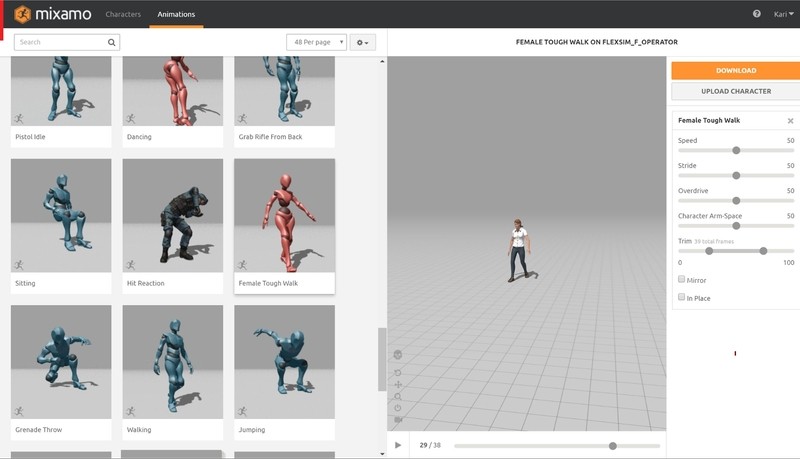
Application: Motion Capture, Keyframe Animation
OS: Browser
Formats: bhv, fbx, obj
Mixamo a free to use web-based 3D animation software with paid content. More than that, it’s even a full-fledged online platform with its own marketplace. The program is focused on automating rigging. You just upload your 3D file and mark the important points of the skeleton that needed to be rigged (usually this means joints), then the program automatically rigs the model, doing all the skinning and weighing itself.
Regarding the animation, the platform lets you use a large library of animation files that you can download (usually at a cost). Some models come with animation available too. After downloading you can export the models with their animation scripts to the other 3D editing and animation software.
If you don't want to pay, there are similar free programs with the same concept: SmartBody and Riggify, that work essentially the same, so we will not cover them in this article.
You can watch a very illustrative tutorial here:
Modo
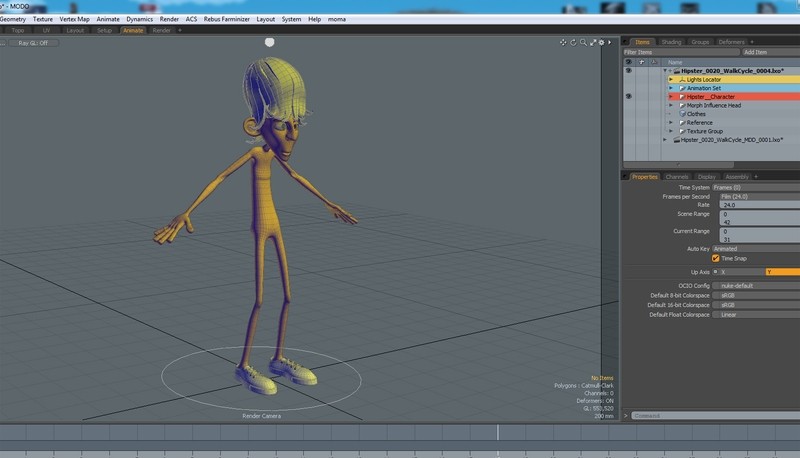
Application: Motion Capture, Keyframe Animation
OS: Windows, macOS, Linux
Formats: lwo, abc, obj, pdb, 3dm, dae, fbx, dxf, x3d, geo, stl
Modo is a paid cross-platform 3D animation software with a free trial available.. It is considered relatively easy to learn and rather beginner-friendly, but it was developed for and widely used by the professional in the VFX and 3D design industries.
It supports polygon and subdivision surface modeling. It has really impressive selection abilities compared to other programs. You can use different selection modes for almost everything: paint selection, pattern selection, only selecting of vertices of certain edges. You can also record macros, and there are good sculpting tools available. Hair, fur and fiber simulation is also pretty useful.
Animation tools draw inspiration from 2D animation workflows. There is a spacing chart and onion skinning. Working with audio files is as direct as it gets – they can be displayed in a separate window, which significantly simplifies lip-syncing your models.
Additive layers, channel modifiers, and constraints are available, as well as various deformers and an inverse kinematics solver.
The software is recommended for both hobbyists and professionals alike, but the price might be considered too high (currently the perpetual license costs $1,799 a year). Gladly there is a free trial and free educational license available.
There’s a good tutorial you can watch to get an understanding of the basics of rigging and animation in Modo:
Poser
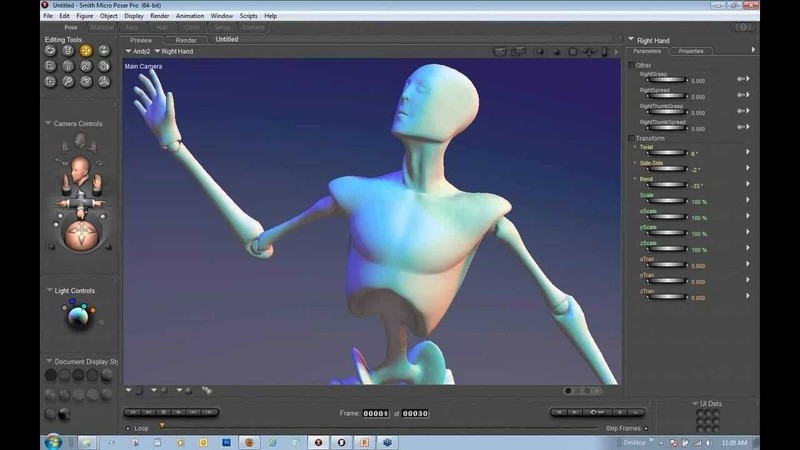
Application: Motion Capture, Keyframe Animation
OS: Windows, macOS
Formats: bvh, cr2, obj, pz2
Poser is a paid (the Pro license costs $349 but there are cheaper versions) character creation and 3D animation software available for Windows and macOS. Character creation is the main point of this program, and you start generating your bipeds by working with a base mesh – a genderless humanoid figure that lacks any distinctive features. Using sliders, you start adding these features to the figure and editing the existing shapes – from hair to legs. After mastering the program you can generate quite convincing and realistic 3D models. The rendered is relatively powerful – for example, it supports subsurface scattering.
Rendering animation is easy as well, there’s a huge library of assets, characters, creatures, and scripted scenes. The models are pre-rigged and are ready to be used. The pro version of the software also allows you to tinker with motion capture using a Microsoft Kinect device. You can edit the data as well. There’s also a walk designer that helps automating walk cycles of your bipeds and quadrupeds. The export to other 3D editing and animation programs is also available.
You can watch a tutorial here:
SmartBody

Application: Motion Capture
OS: Windows, Linux, macOS, Android, iOS
Formats: af, bvh, dae, fbx, sk, xml
SmartBody is a free cross-platform (even Android and iOS are supported) 3D generation and animation software developed at the USC Institute for Creative Technologies. You can use 3D scanning using a Kinect, and create a 3D character in no time. There are character editing tools that can change the way the models look. Then there is also an auto-rigging tool that works wonders and an impressive amount of 3D animation tools. Among the features, there are lip-syncing, object manipulation and retargeting. Keyframe animation is also supported.
SmartBody can be used with game engines natively – for example, it supports GameBryo, Ogre, Unity and Unreal engines out of the box.
Here’s a video that shows how auto-rigging works in SmartBody:
Terragen

Application: Keyframe Animation
OS: Windows, macOS, Linux
Formats: chan, clip, exr, fbx, geo, lwo, mov, obj, ter
Terragen is a paid (inexpensive and the free version is also available) cross-platform 3D design and animation software. The main focus of the program is creating and rendering extremely photorealistic landscapes. It’s often used for video game design and architectural visualization. The workflow is based on a procedural nodes system and every little detail in the landscape can be configured. A sophisticated shader system gives an impressive control over texturing and surface manipulation. Using a powerful procedural nodes system, the user has full control of his creation. Volumetric clouds, fog, sky, the sun, and the stars can be rendered as well. There are also preset landscape elements such as trees that can be added to your creation. Digital Elevation Model (DEM) files of the real-world landscapes can be imported into Terragen as well.
You can also animate quite complex scenes: the parameters for almost everything (including atmospheric effects) can be animated and set in keyframes. You can control terrain displacement and sync it within the timeline, which will give you jaw-dropping time-lapse effects of landscape changes happening over time. Everything can be previewed in real-time.
There are also many features available for the camera: motion blur, aperture, focal length. Some modes allow you to use the renders in VR and movies with stereoscopic 3D effects.
Various file formats are supported and your works can be exported to other programs.
Terragen is powerful and doesn’t cost a lot: the Creative perpetual license starts at $349, the Professional one – at $699. There’s a free version but it’s rather limited – no animated and the renders are low-res, and it must not be used for commercial projects (well, it can be, but only up to 30 days after downloading). The educational license also exists.
You can watch a quick tutorial on animating the camera in Terragen 4 here:
Stop-motion software
Dragonframe
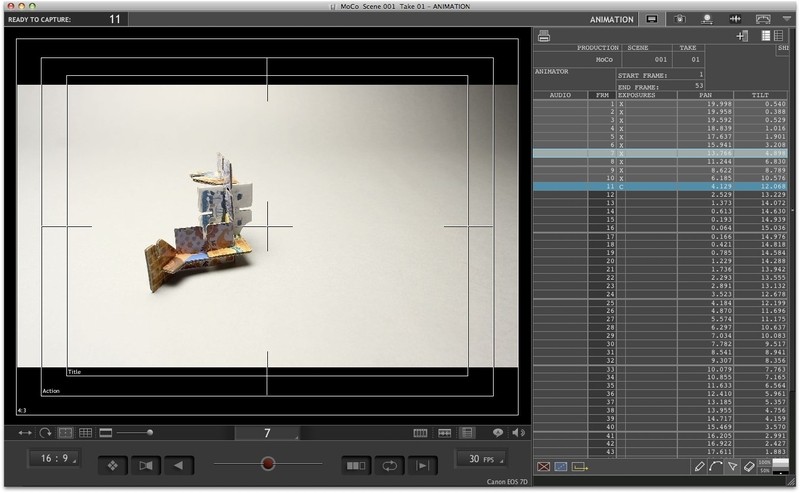
Application: Stop Motion
OS: Windows, macOS, Linux
Formats: avi, mov, mpg
Dragonframe is a paid cross-platform industrial-grade stop motion animation software. It’s widely used in the large projects within the industries, the majority of expensive movies using the technique are made with Dragonframe. For example, ‘Coraline’. The functionality is extensive: drawing tools allow you to outline motion paths, the X-sheet helps to track the progress, reference videos can be added to the program’s screen. There is a deep control over your camera’s manual functions: ISO, shutter speed, aperture, and the program supports motion controls. The lights can be controlled in up to 512 channels and the onion skinning feature is supported.
The software supports different cameras from Canon, Nikon, Sony and others.
The viewport can be overlayed with various grids to aid you in compositing balanced shots. This animation software supports a host of cameras from known manufacturers like Canon, Nikon, Sony and more. You can import face sets as Photoshop files for references and also work with multiple audio tracks.
The software costs $295 for a version with USB controller and $305 for a version with a useful Bluetooth controller. A free trial that lasts 30 days is also available.
Here’s a tutorial:
Boats Animator

Application: Stop Motion
OS: Windows, macOS, Linux
Formats: avi, mov, mpg
Boats Animator is a free and open-source cross-platform stop motion animation software. Its user interface is clean and intuitive, so the program is good even for complete beginners. But there are powerful features that make Boats Animator suited for the professionals as well. For example, it supports onion skinning, which makes positioning your models much easier.
The frames can be played instantly, which makes the workflow quicker. The reason for it is extensive use of web technologies such as HTML, JavaScript, and WebRTC.
You can watch an example of a motion animation made using Boats Animator here:
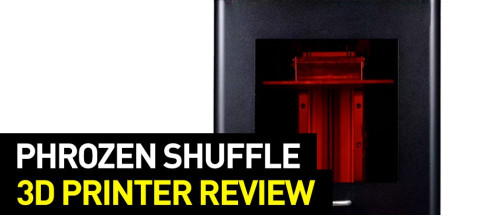
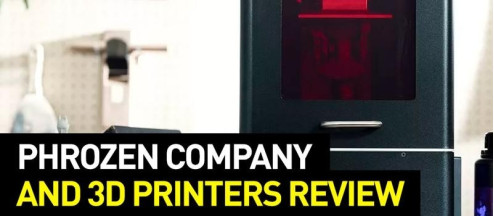
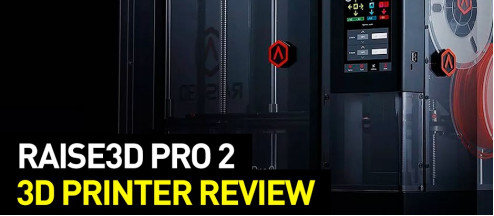

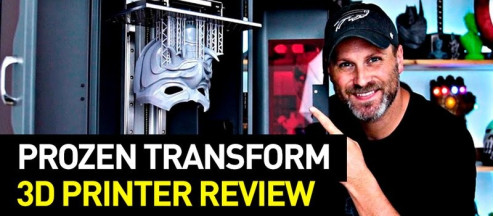
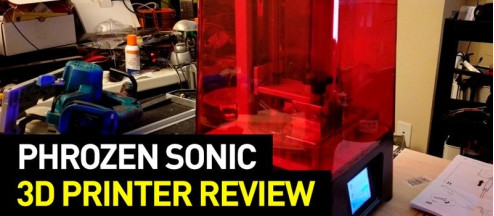
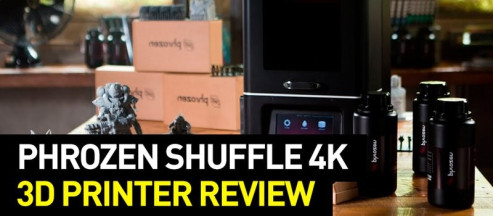

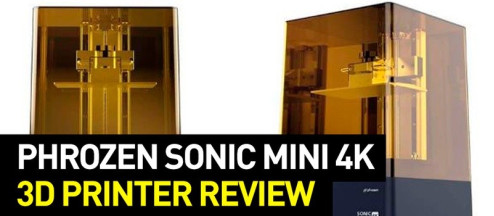

Write a comment